Quito Highlights – TeleferiQo & Much More
In my first post from Quito I described a walking tour through the UNESCO World Heritage Site historic centre of this amazing city. It was led by Alfredo Meneses our Adventures Abroad guide and was the kickoff of a 14 day Experiential Ecuador Tour that will take us to the Galapagos Islands and the Amazon Basin. In that same post I strongly advised arriving in Quito at least a day early for a number of reasons, not the least of which is to get acclimatized to the 2,850 metre (9,850 feet) elevation of the city. In this post I’ll suggest some Quito highlights that you might want to take in with that extra time including a cable car up Mount Pichincha, a visit to the home of Ecuador’s most famous artist and more churches than might be healthy for a religious skeptic. I’ll also drop a hint as to how to avoid being victimized by one of the most common scams in South America.
Quito Highlights – A Few More Churches
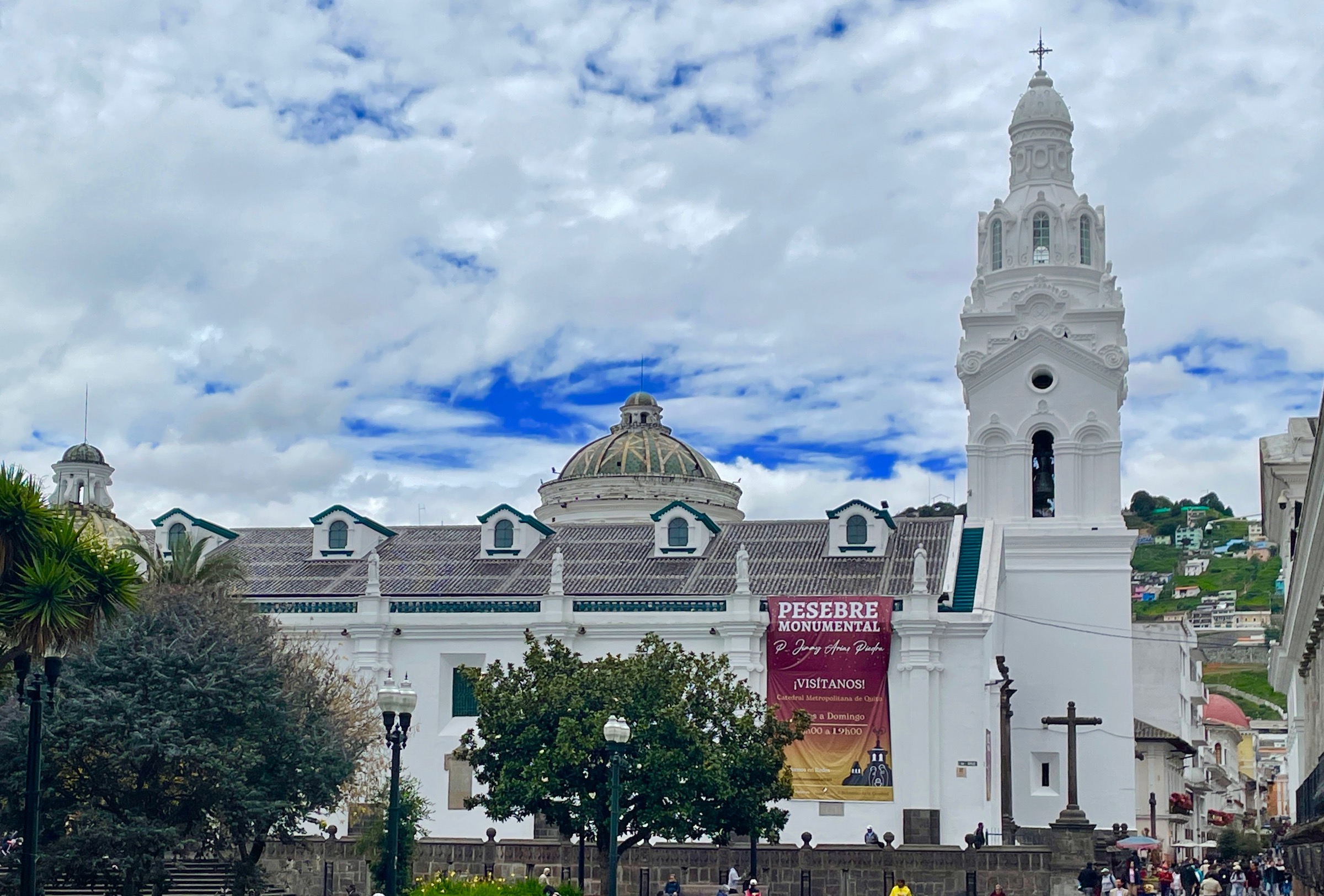
I was only being facetious in my comment about churches. Even non-believers can appreciate the exquisite architecture, both inside and outside, of the baroque churches in the historic centre of Quito. On our walk with Alfredo with saw the churches of Santo Domingo, San Franciso and the Jesuit’s La Compañía with its absolutely mind-blowing golden interior. We also saw the exterior of the Metropolitan Cathedral shown above, but did not go in. If you take this tour at the same time of year that we did in November, you will in all likelihood see this Pesebre Monumental banner hanging from the side. It loosely translates as monumental manger and is definitely worth paying the small admission fee to see. Essentially most of the interior of the church has been turned into a giant Bible story in miniature with hundreds of moving figures.
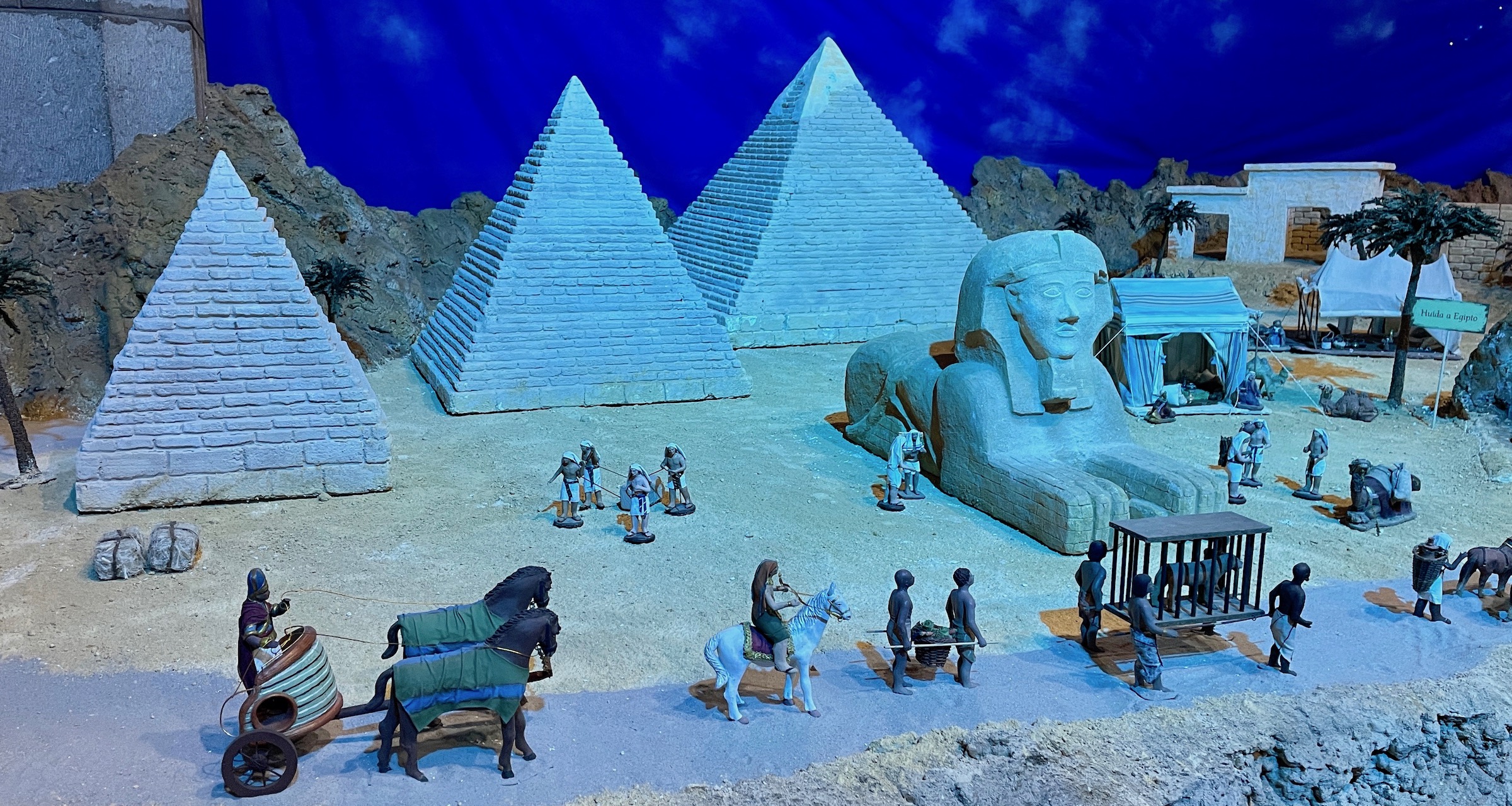
This is the beginning in Egypt.
And this is near the end with the nativity scene.
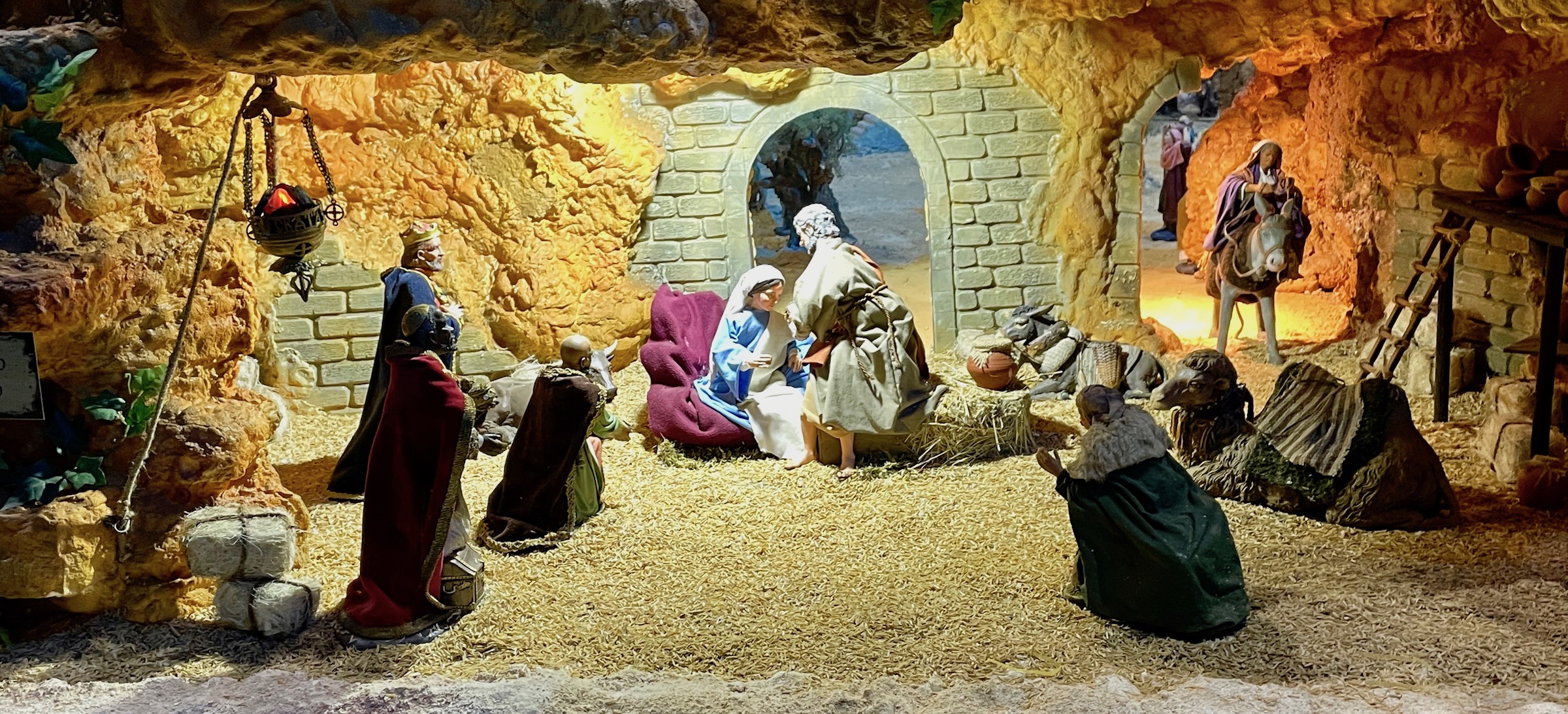
What made this worthwhile was not just viewing the the Pesebre Monumental, but seeing the looks of adoration on the faces of the people who were also viewing it. Multi-generational groups were making their way very slowly around the display in obvious reverence of what they were seeing. This was my first hint of just how strong a hold the Catholic Church still has on the minds and hearts of most Ecuadorians, something that was confirmed many times over during the course of our visit to Ecuador.
The Metropolitan Cathedral contains some of the best examples of the Quito school of painting which you can look at, but not photograph. It also contains the tomb of Ecuadorean national hero Mariscal Sucre, which you can photograph, albeit in low light.
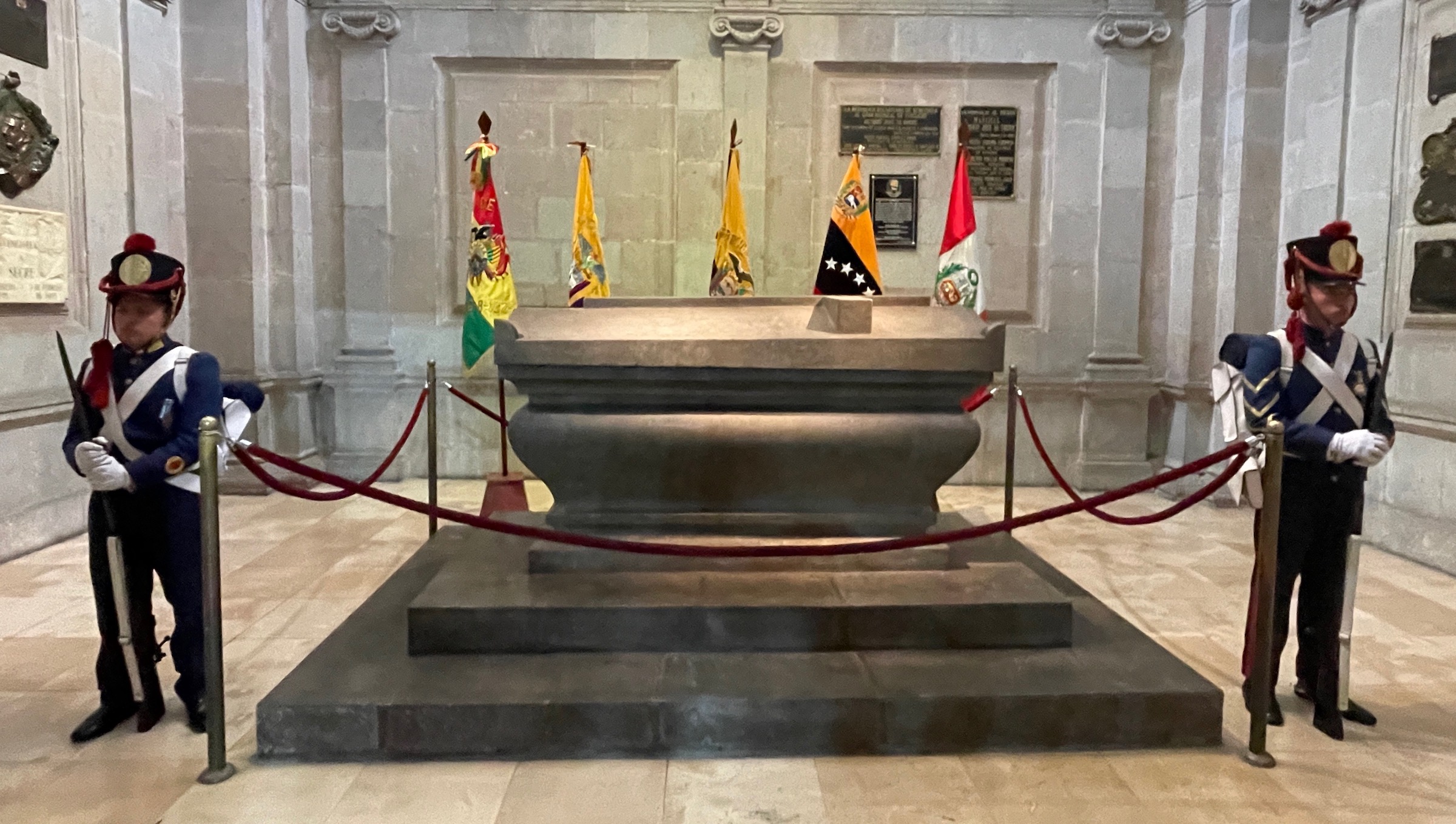
Sticking to the church theme of Quito highlights you only need to go a few steps from the Metropolitan Cathedral to find the El Sagrario which is technically a chapel of the cathedral, but with its own entrance. It is one of the few Quito Baroque style churches that permits interior photography and it’s definitely worth seeing if only for this fantastic altar.
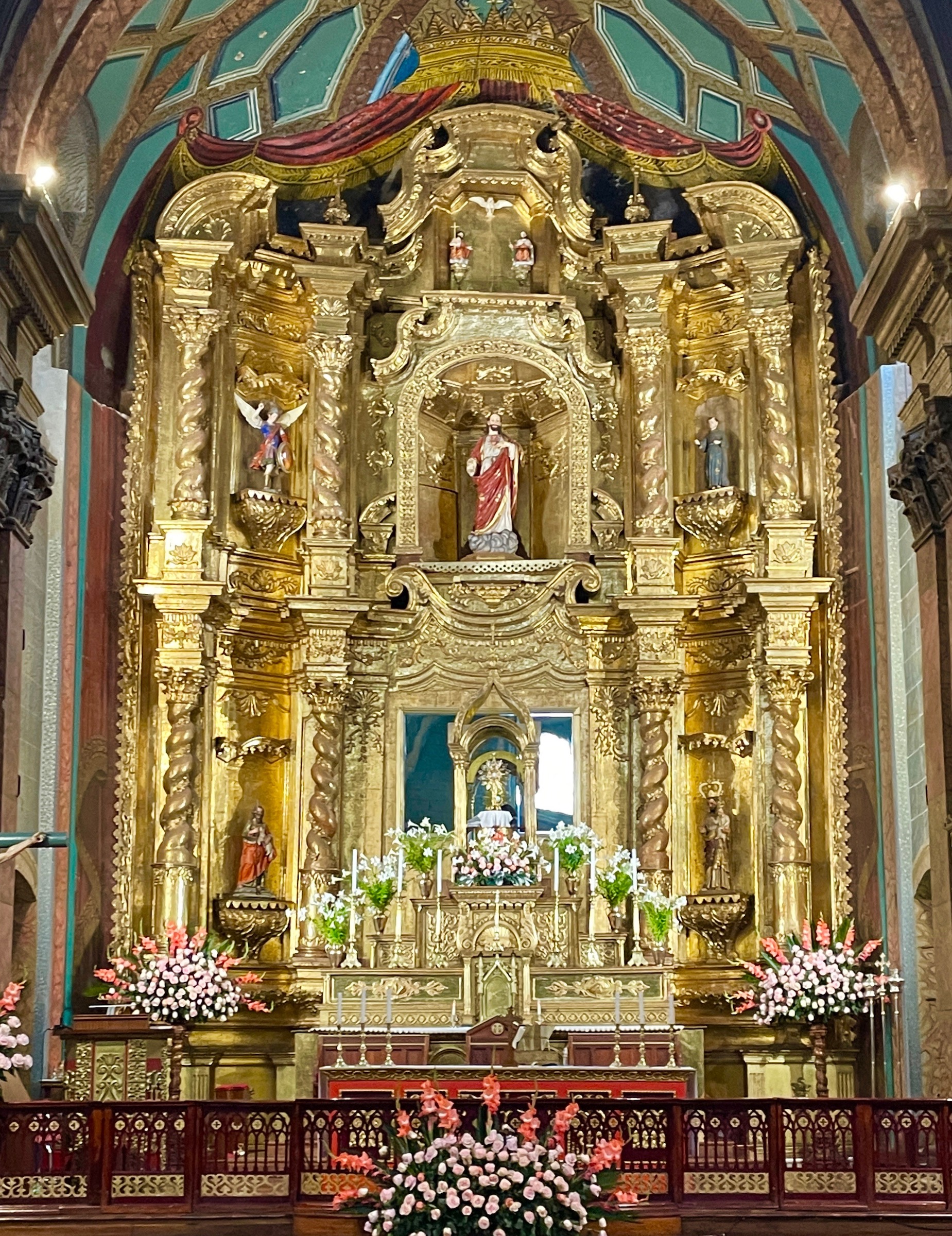
However, I found this intricately carved wooden interior gate by Bernardo de Legarda even more compelling. He was the master sculptor of the Quito Baroque and his works are seen in all the major Quitoean churches, the most famous of which is the Virgin of Quito in the Church of San Francisco from which the huge Virgin of El Panecillo that towers over Quito was modelled.
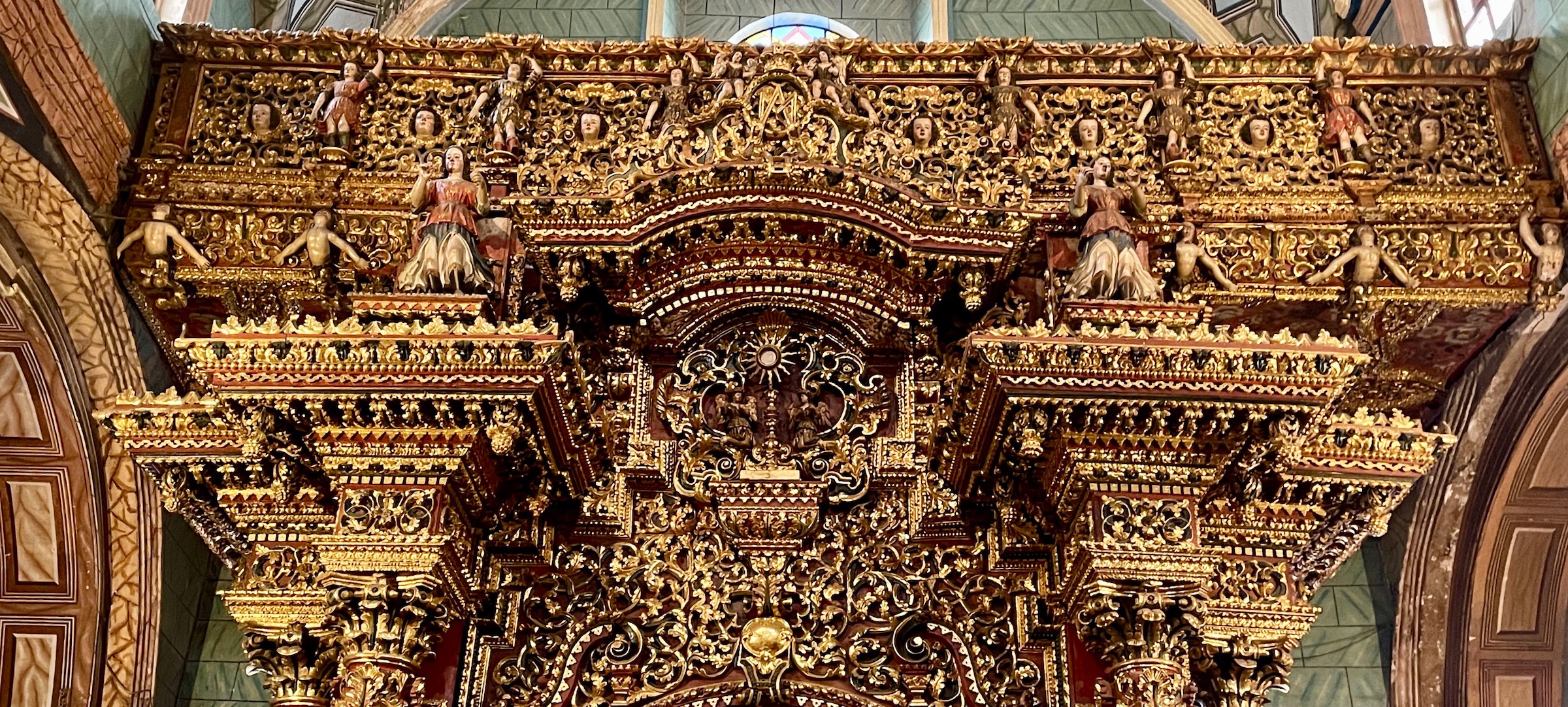
The exterior doors are also interesting with a number of these carved cross-eyed heads, representing God knows what.
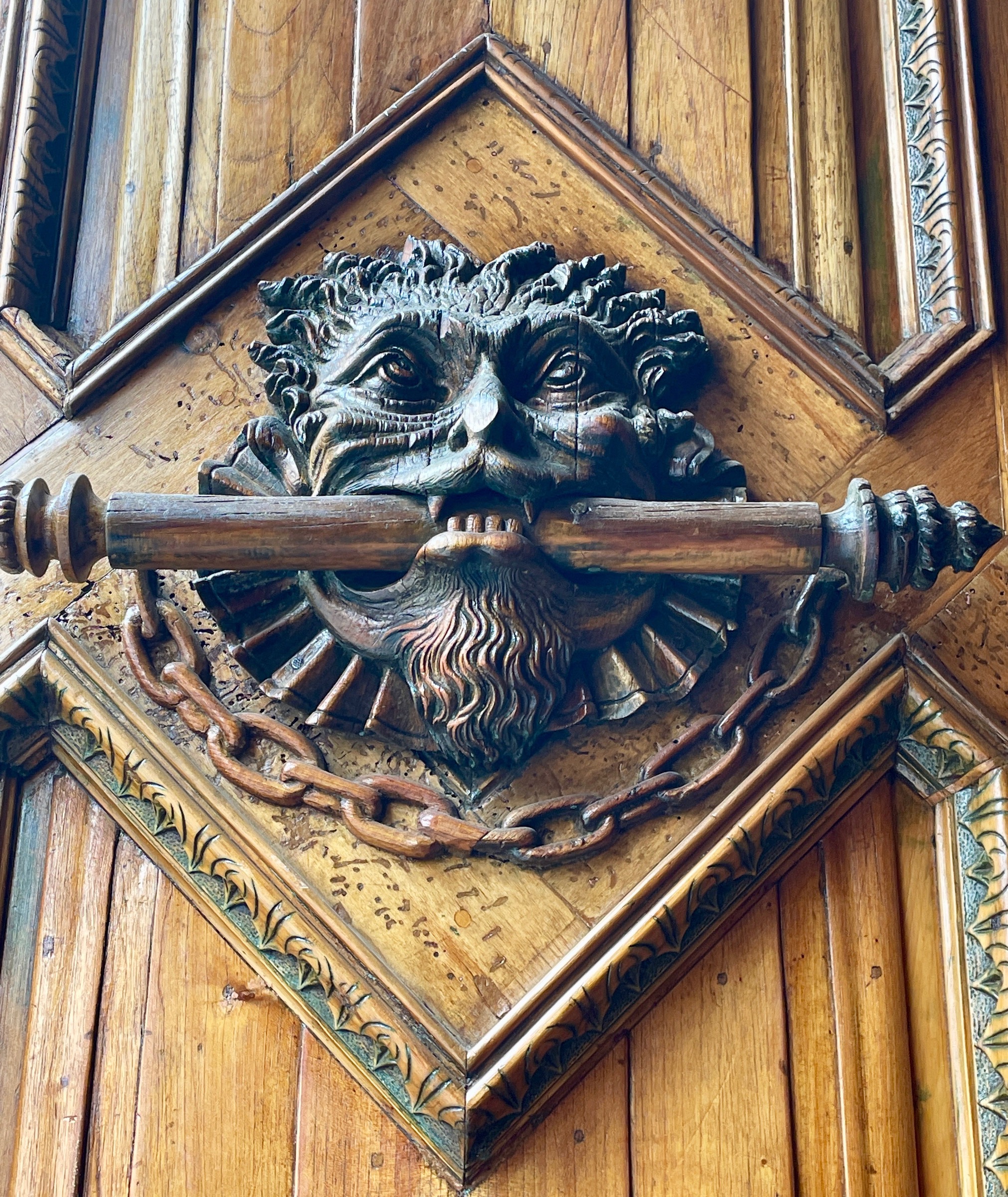
No tour of the Quito highlights would be complete without a visit to the National Basilica which you can reach by following Garcia Moreno street all the way up to the hill upon which this neo-Gothic colossus sits.
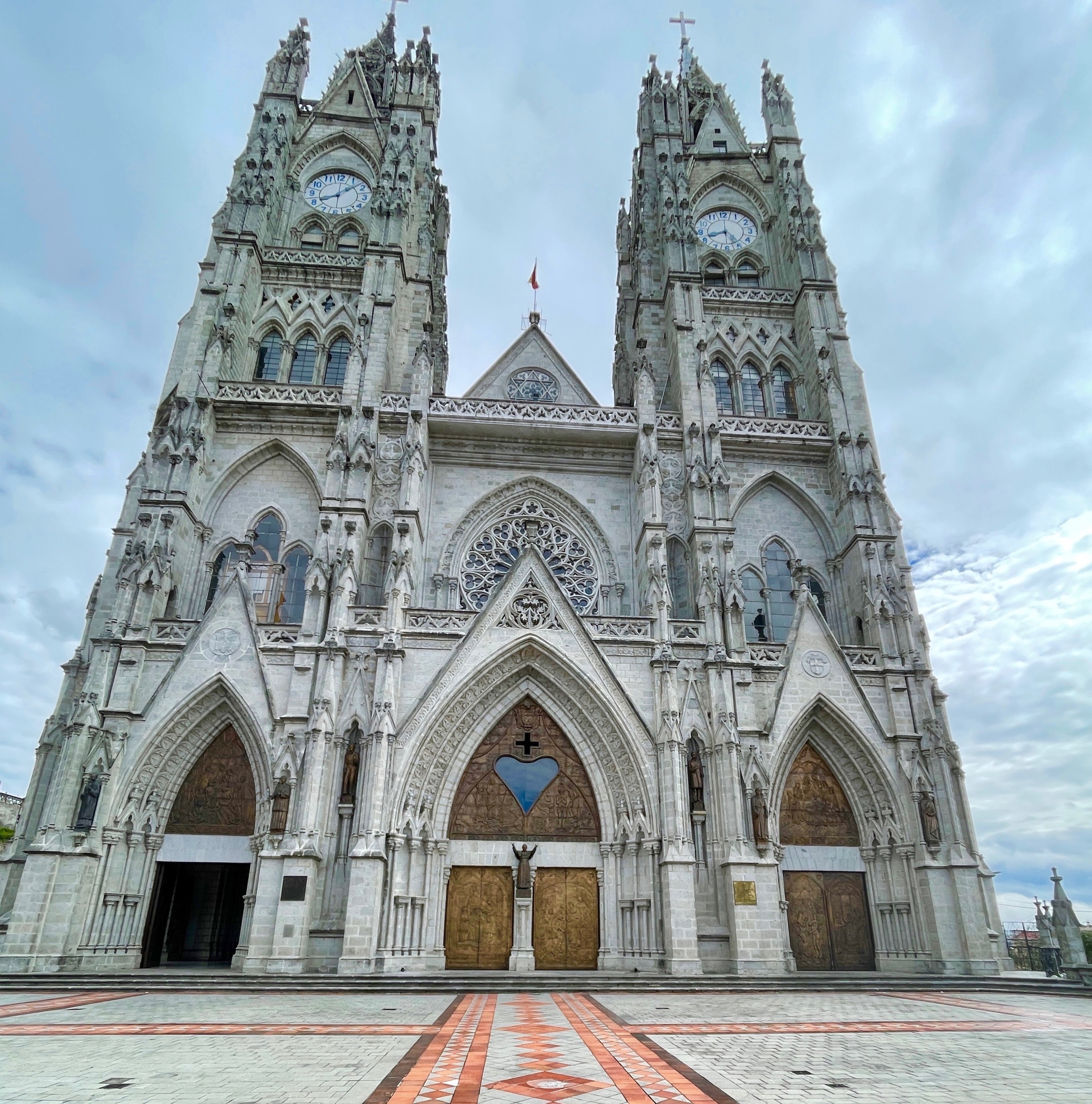
In the late 1800’s Ecuadorean politicians must have had more money than brains as they used taxpayer’s money to build the National Basilica at a time when you would think the city had an overabundance of places to worship. Putting up two clock towers is never a good idea as the two clocks can never agree on what time it is – ten after eight or twenty after? Probably fifteen.
Taking a closer look by walking straight to the middle doors you see some exquisite bronze doors depicting scenes from the life of Jesus, the Creation and the arrival of the Spanish. This one shows a very un-Ecuadorean looking God overseeing Adam and Eve.
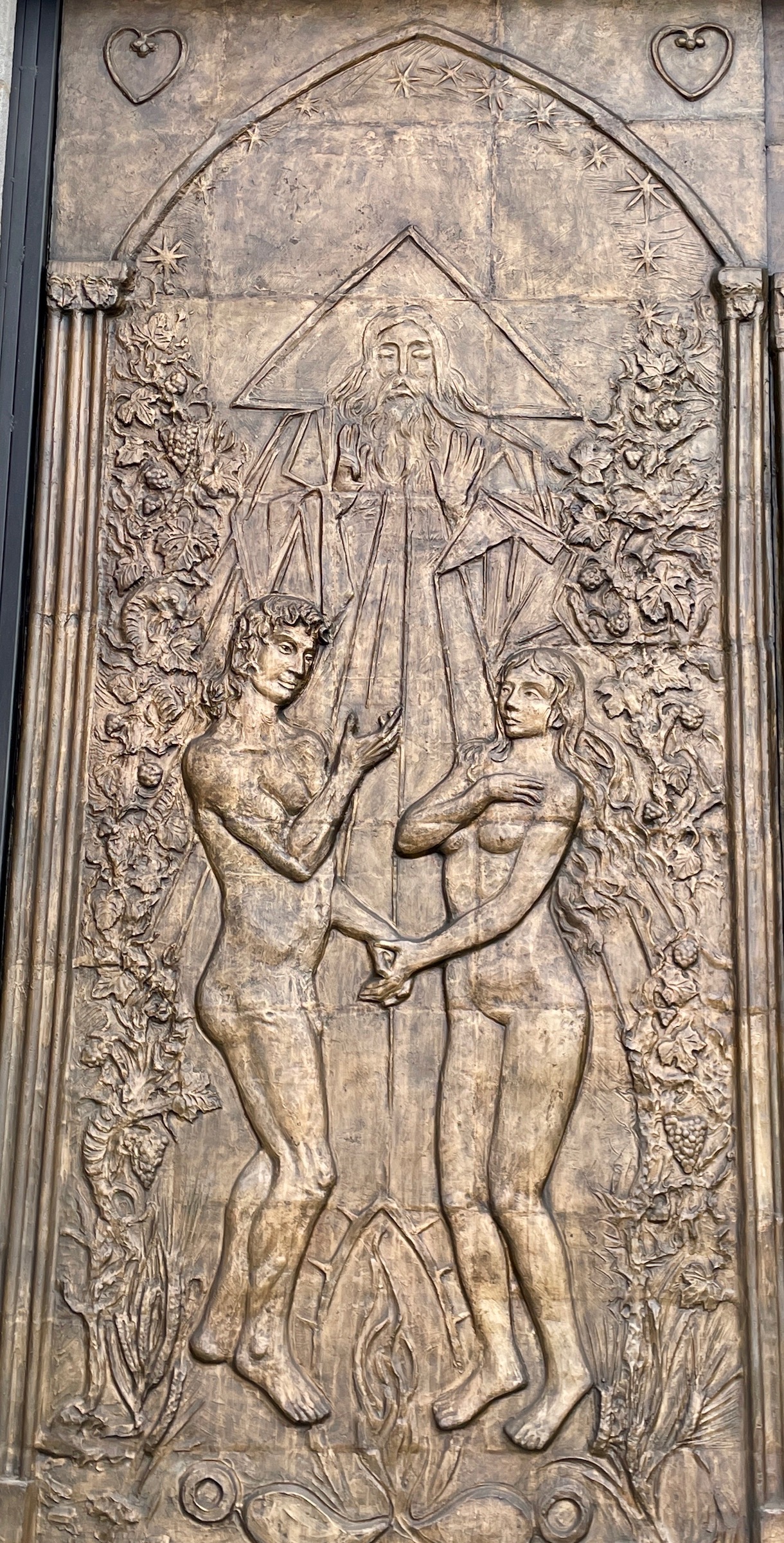
More interesting is this door from the arrival of the Spanish panels depicting the baptism of the natives. Looking closer you can see a number of Ecuadorean animals including a condor, llama, iguana and toucan.
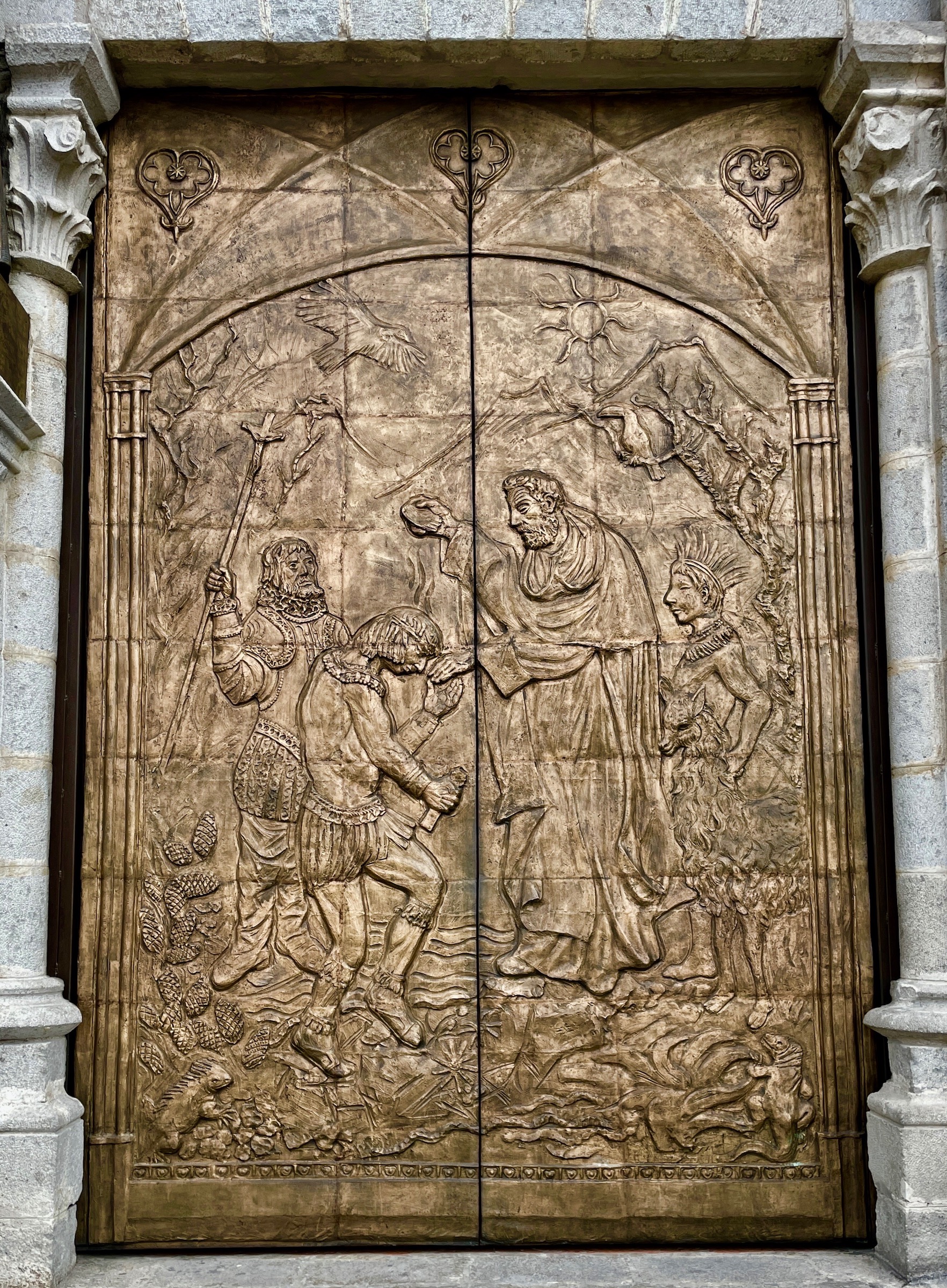
The blending of Ecuadorean themes with Gothic architecture continues in many places in the basilica. The gargoyles are not your traditional gaping monsters, but boobies, armadillos, monkeys and others.
Inside it does resemble one of the great European Gothic cathedrals with barrel vaulted ceilings.
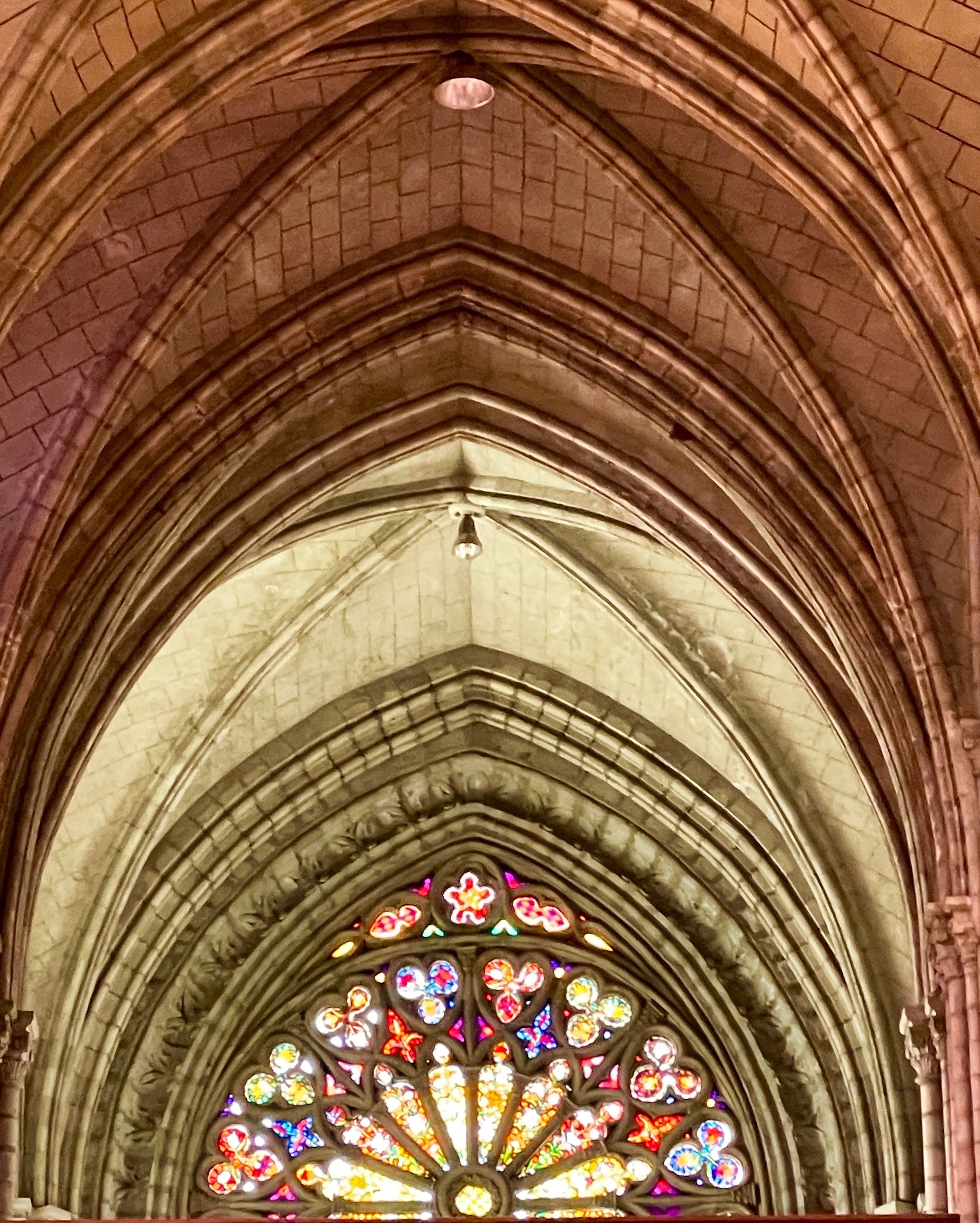
Lots of stained glass including rose windows that very much imitate those of Notre Dame in Paris which apparently was the inspiration for the French architect Emilio Tarlier.
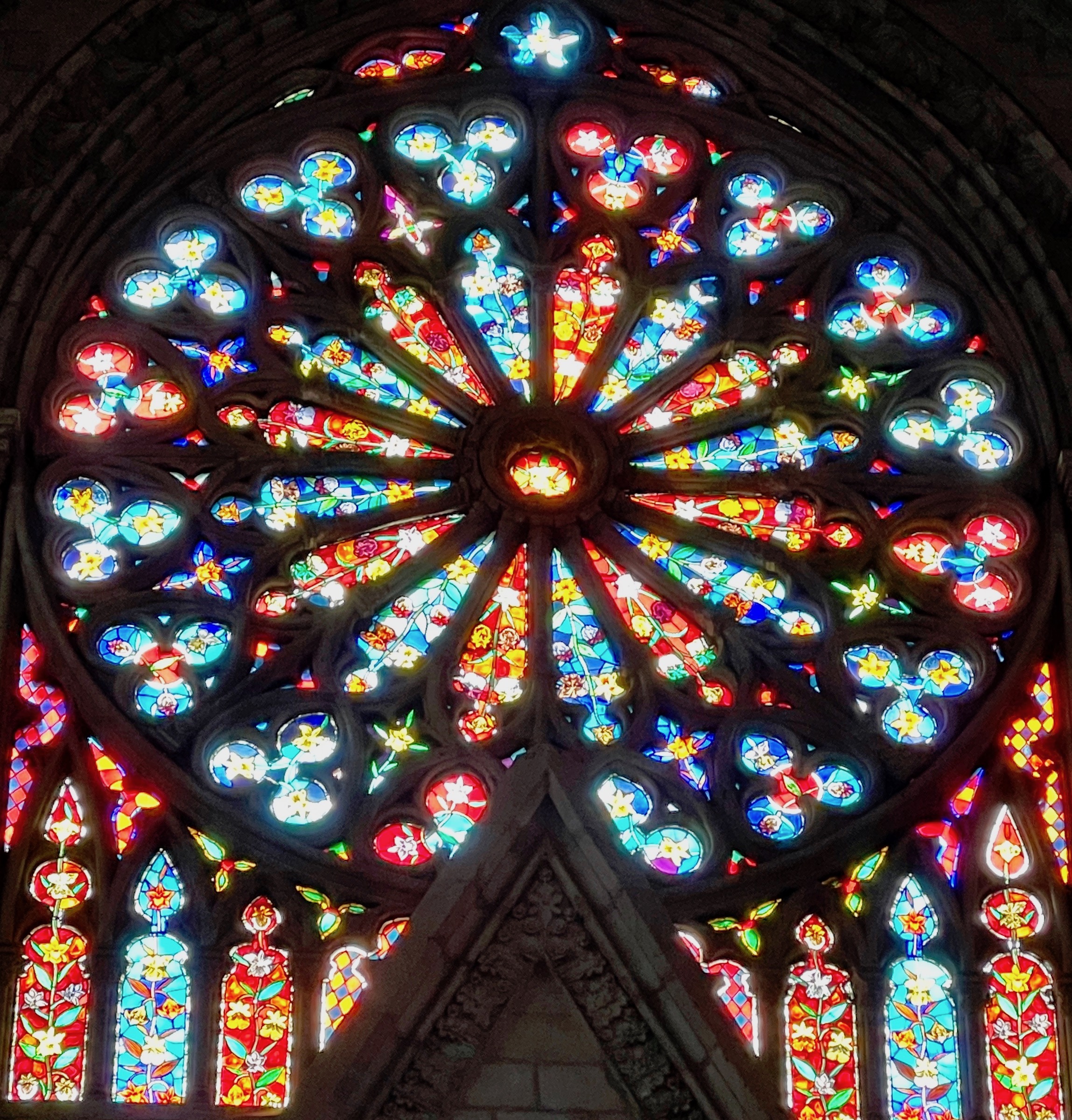
I’m not sure why, but during our visit the two towers were not open, but apparently they usually are. From these you can get an unparalleled view of the city and the valley in which it is situated.
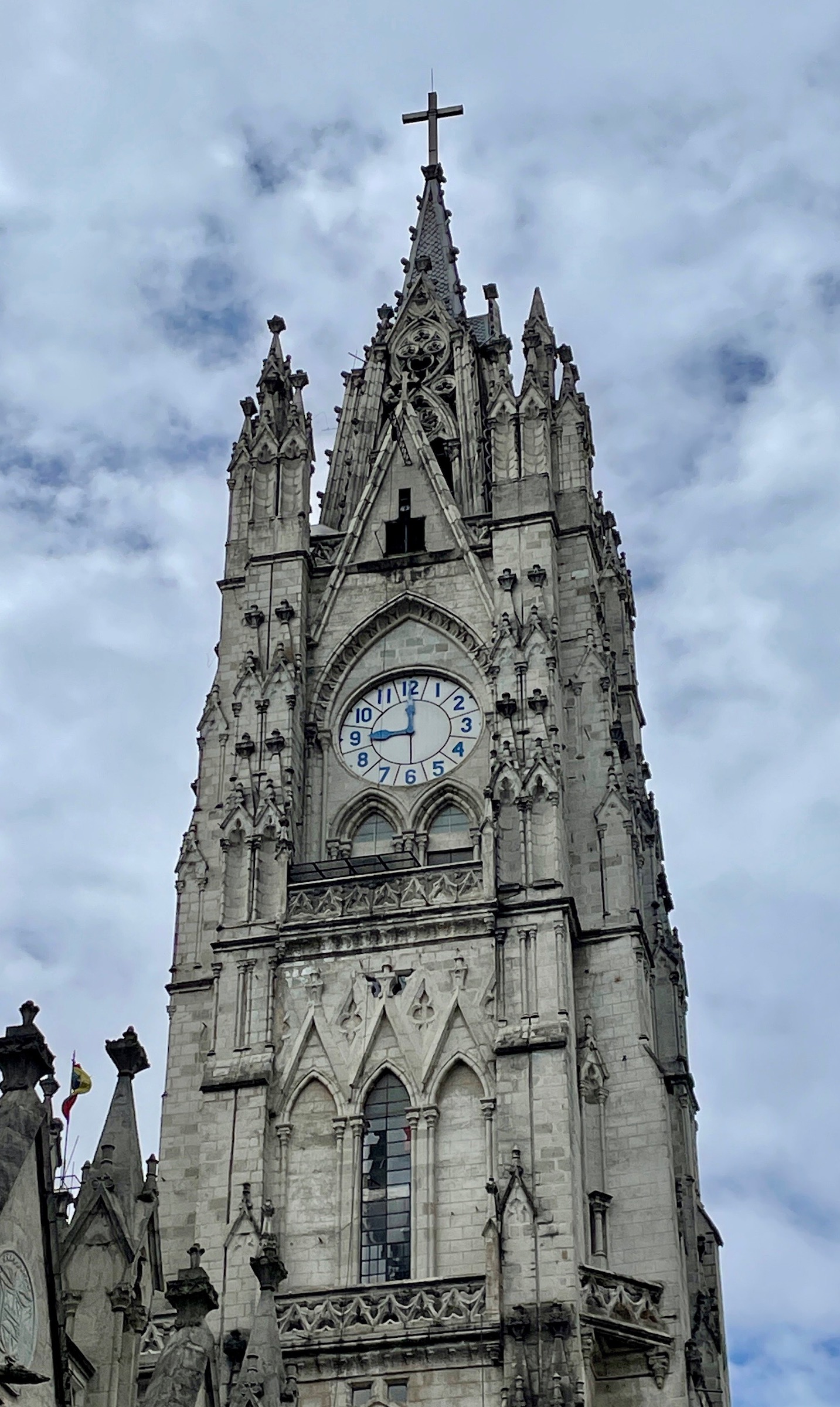
However, even if you don’t get to climb to the top of the basilica you still get this Quito highlight – the view back to the Virgin of El Pancillo and the historic city centre below.
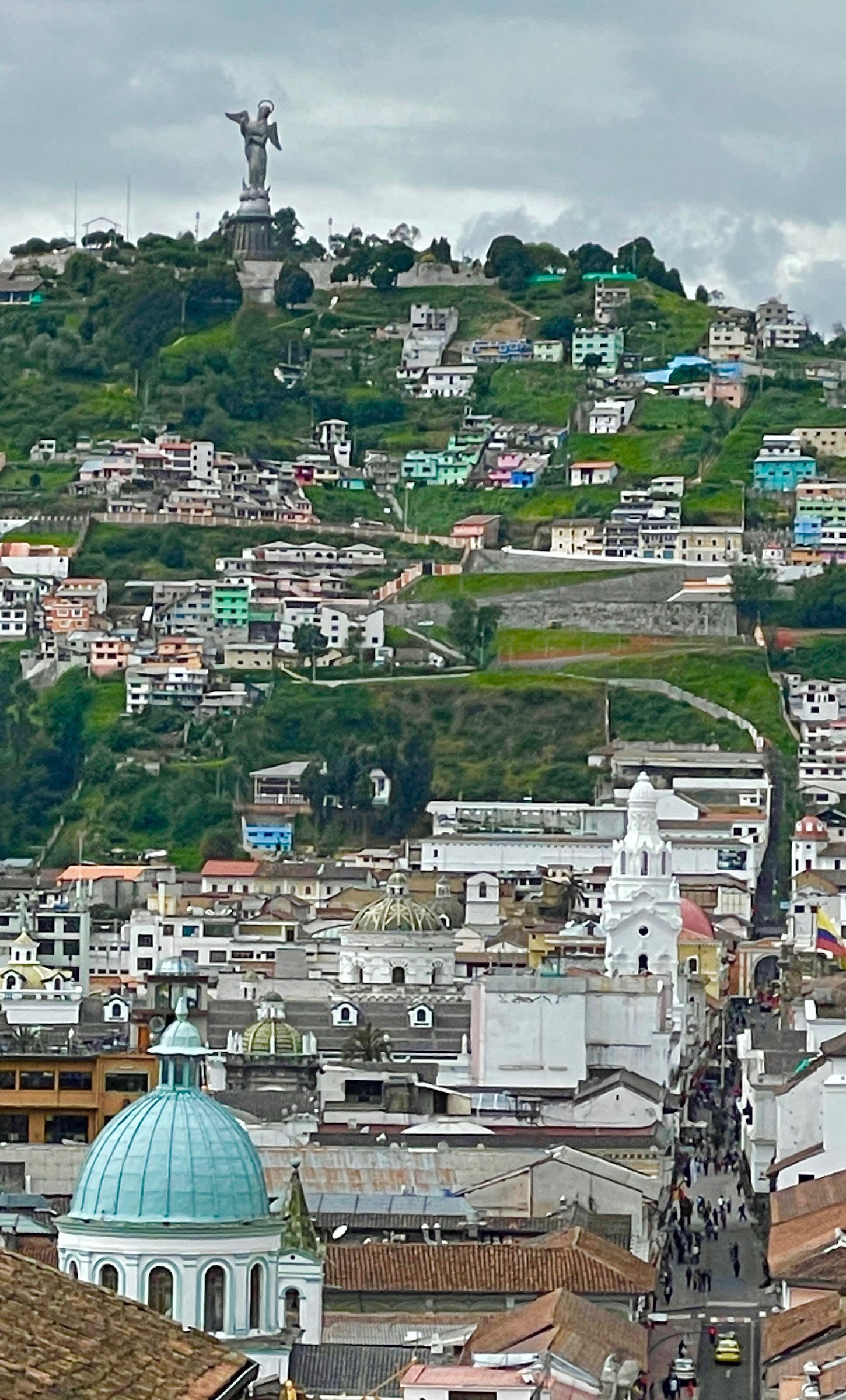
Quito Highlights – The Capilla del Hombre
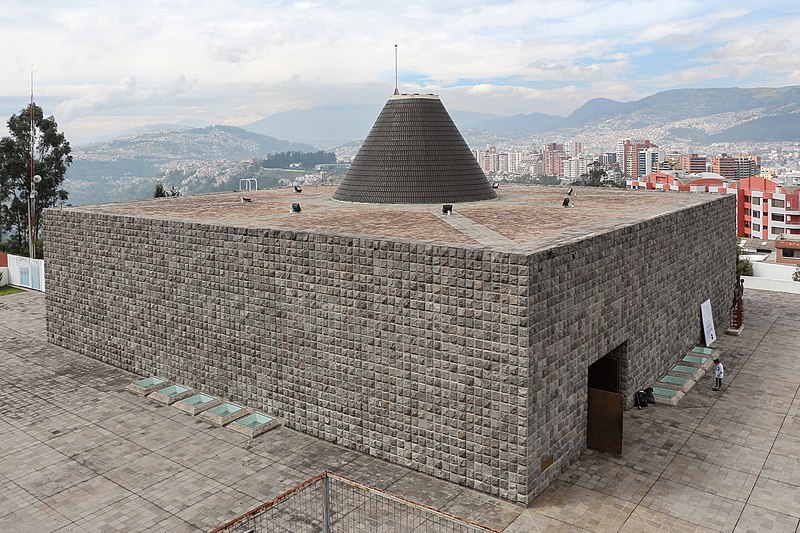
For the final two Quito highlights you will need to take a taxi, but they are ridiculously cheap and ubiquitous in the historic district. If you are nervous about just hailing one on the street get the hotel to call one for you. Just make sure the driver puts the meter on, which was not an issue in the five or six cab rides we took in Quito.
Oswaldo Guayasamín is an Ecuadorean national treasure and the greatest artist ever produced by that country. His works or copies thereof are found throughout the country. You can see some of them in the Quito airport. He was of mixed Kichwa and Mestizo descent, growing up dirt poor, but with an innate talent that could not be suppressed. Very much influenced by Picasso and the Mexican muralists, particularly José Oroszco with him he travelled extensively, his works focused on man’s inhumanity to man and the daily human struggle. He was recognized at a young age throughout the art world as a creative genius and like Picasso and many other artists originally obsessed by war, poverty and other ills, he became very well off by depicting these things in his art.
The Capilla del Hombre, which is essentially an anti-church dedicated to man and not God, was built on the grounds of his estate in the tony Bellavista district of Quito that overlooks the city below. It features only a small number of works by Guayasamín, but in such a manner that you can appreciate the depth and power of his work. It was designed by the artist who sadly did not live to see its opening in 2002. Also included in the admission price is a tour of the artist’s home and studio which is almost as interesting as the gallery.
It was raining a bit when we arrived so I couldn’t get a good exterior shot of the unusual building and got the one above from Wikipedia. This is Alison heading up the lane from where you descend stairs to the Capilla del Hombre.
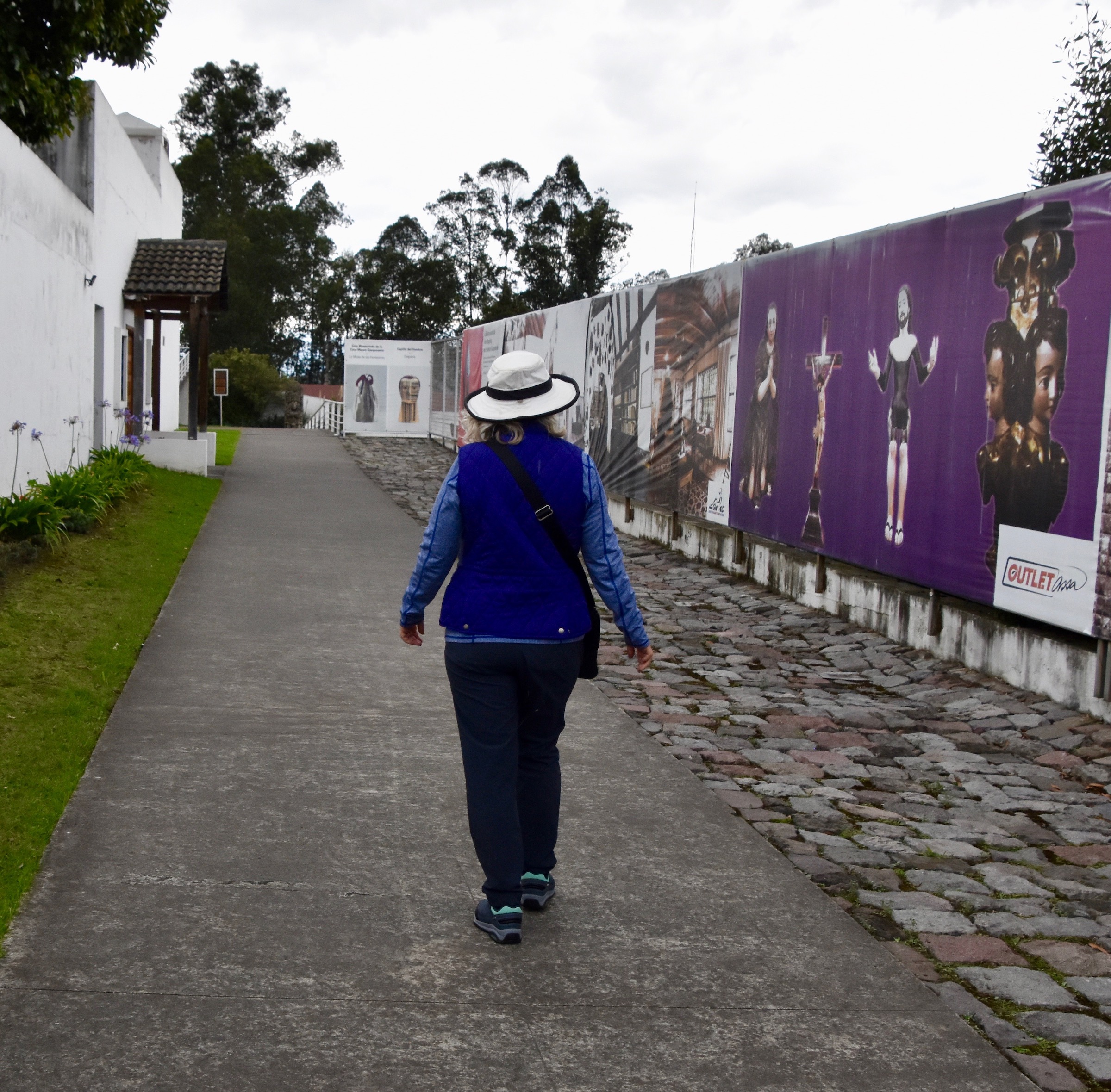
We were given a guided tour which took about half and hour and greatly enhanced our understanding of the artist’s various styles and periods, again very much like Picasso. The main floor is an entirely open circle that features these and other huge canvases in a clearly cubist style.

In the centre you can look up at the conical ceiling to see these emaciated figures that Guayasamín never did finish.
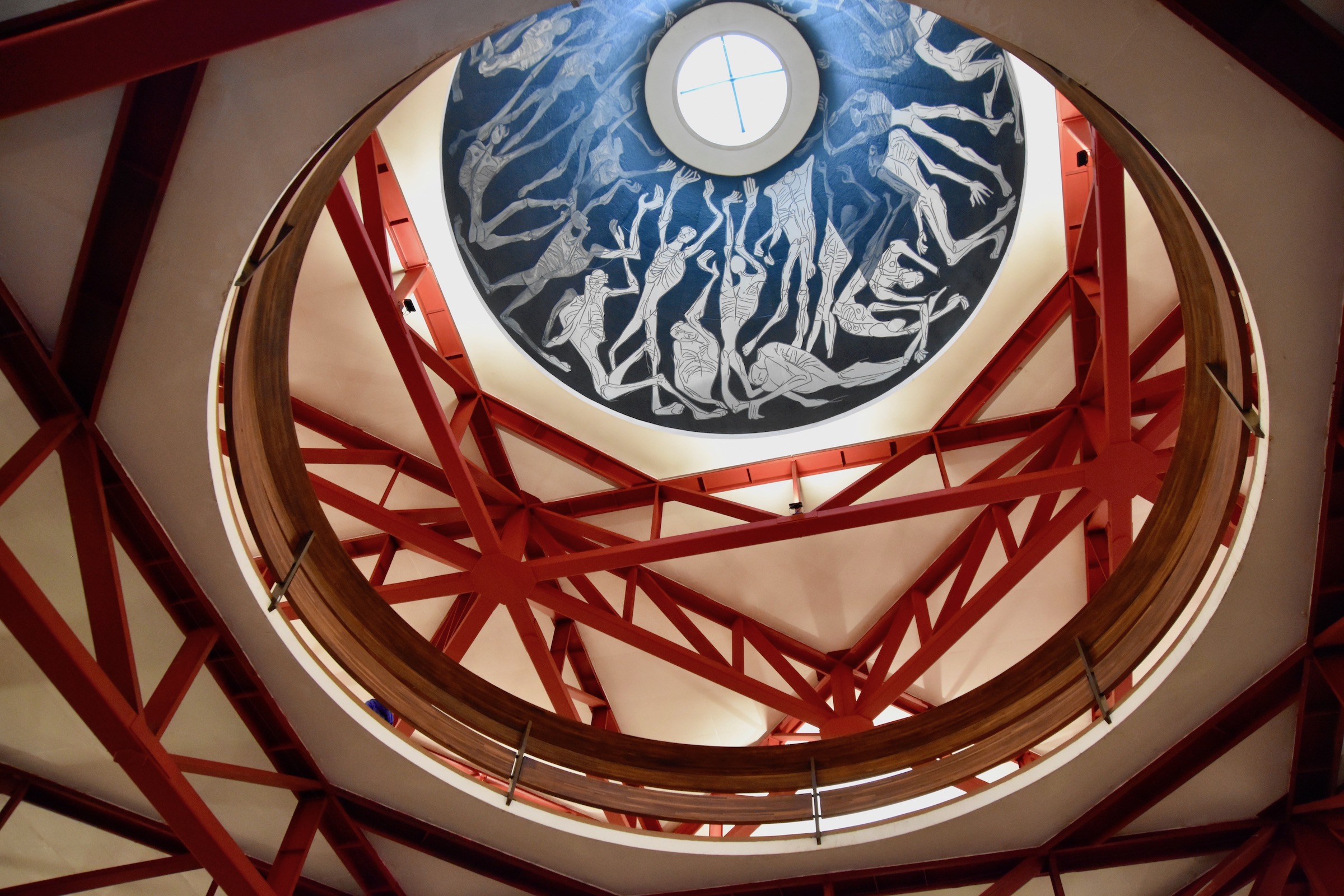
I could do an entire post on the Capilla del Hombre featuring a dozen or so of his most impressive works, but this is a Quito highlights post so I’ll limit it to three. This is The Dictator’s Face and is portrays everything you need to know about the Latin American strongmen that have mired the area in corruption and cruelty for seemingly forever.
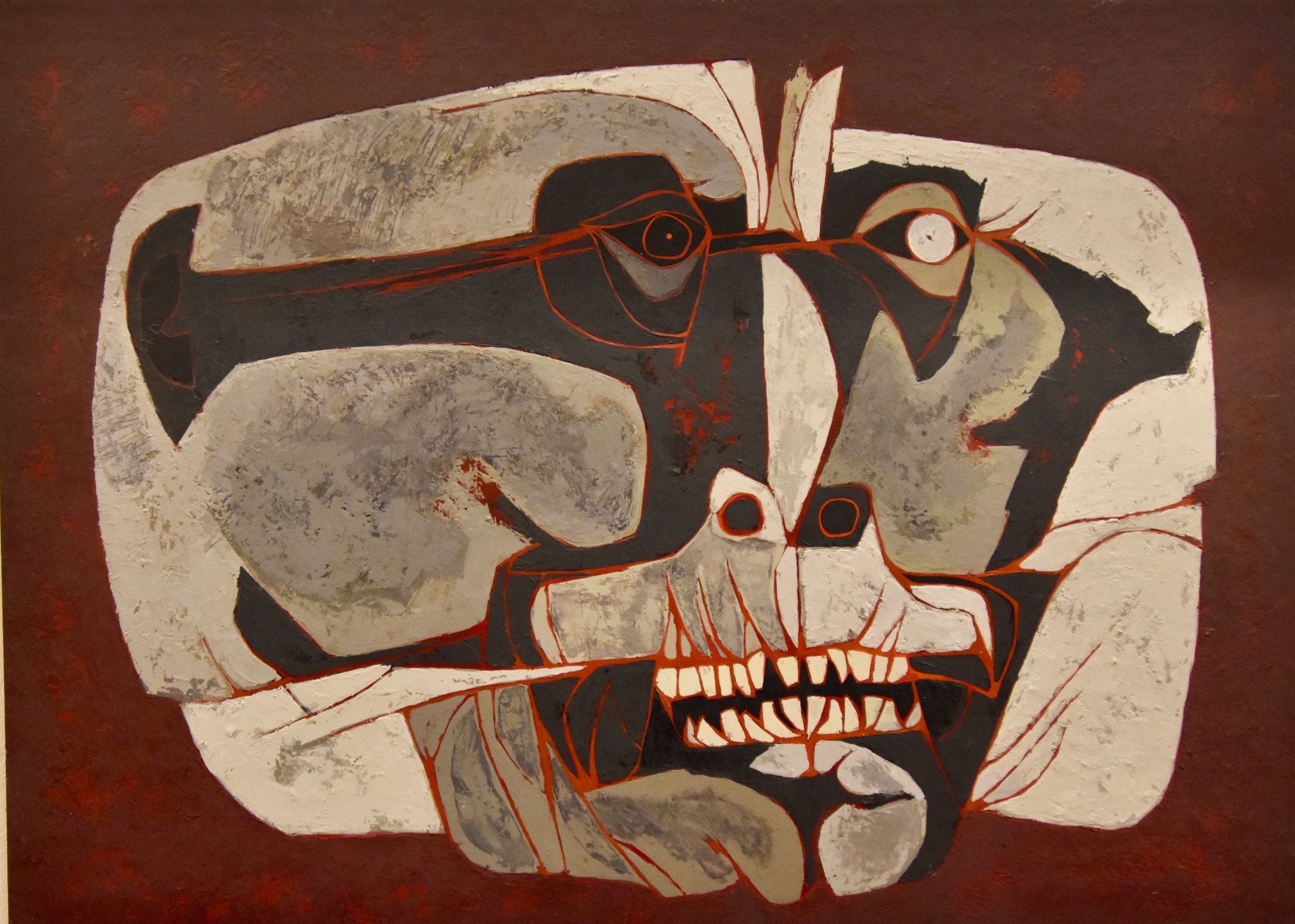
And this is a depiction of man’s cruelty not only to each other, but to animals as well. You may recall that in the first post from Quito we visited the Independence Monument where a condor, representing the people of Ecuador, sits triumphantly above a dying lion, the symbol of European colonialism. This painting, which is huge, depicts the same theme with the Europeans represented by a bull rather than a lion. However, there is more than just symbolism to this painting. Apparently it was once common practice in some Andean communities to tie a starving condor to the back of a bull and see what the outcome might be. Pretty sick and according to some sources it still occurs in places in Peru.
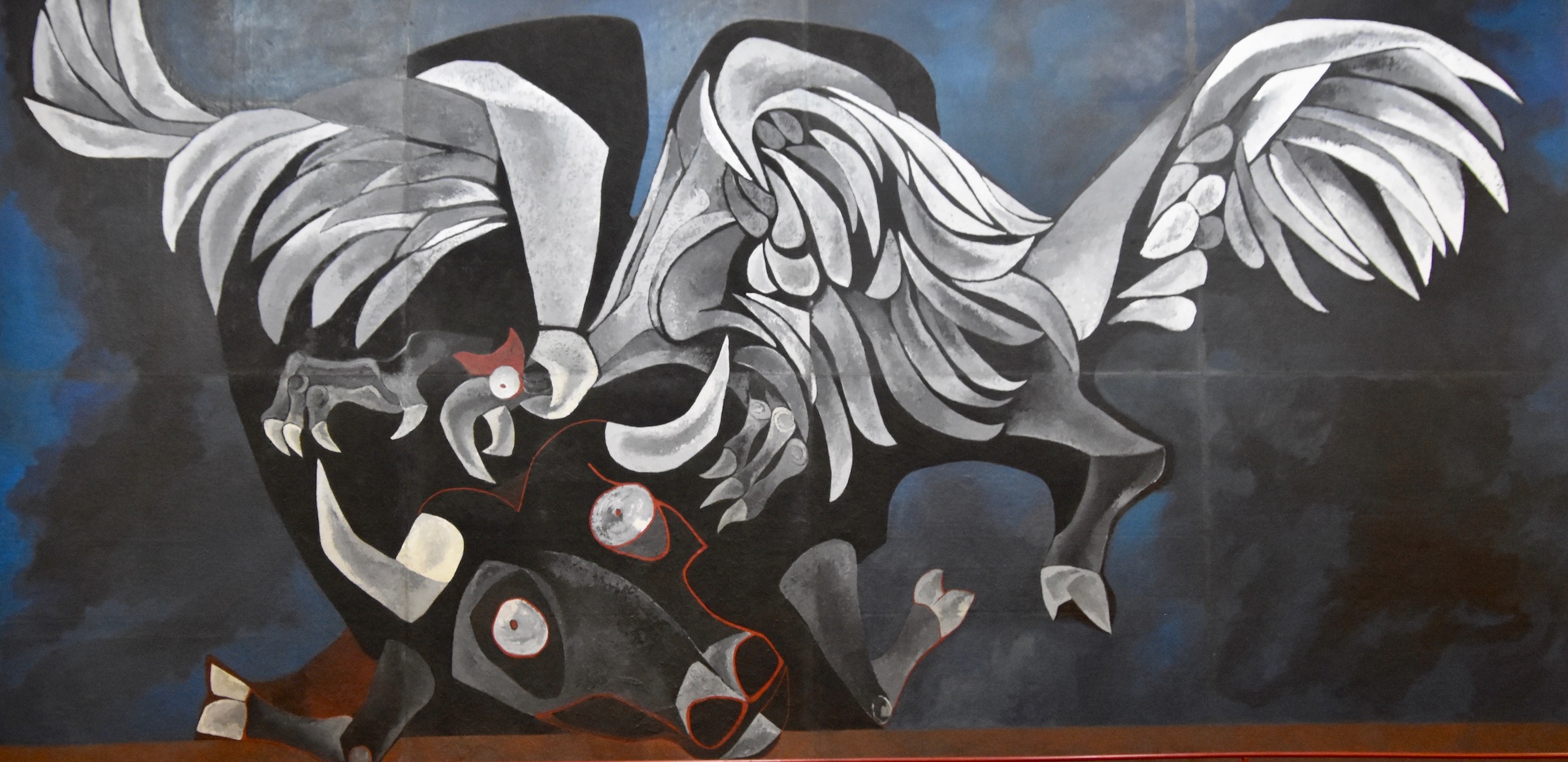
Not all of Guayasamín’s works are downers even if most are. This is a depiction of Quito with Mount Pichincha bathed in sunlight, or is that lava about to engulf the city?
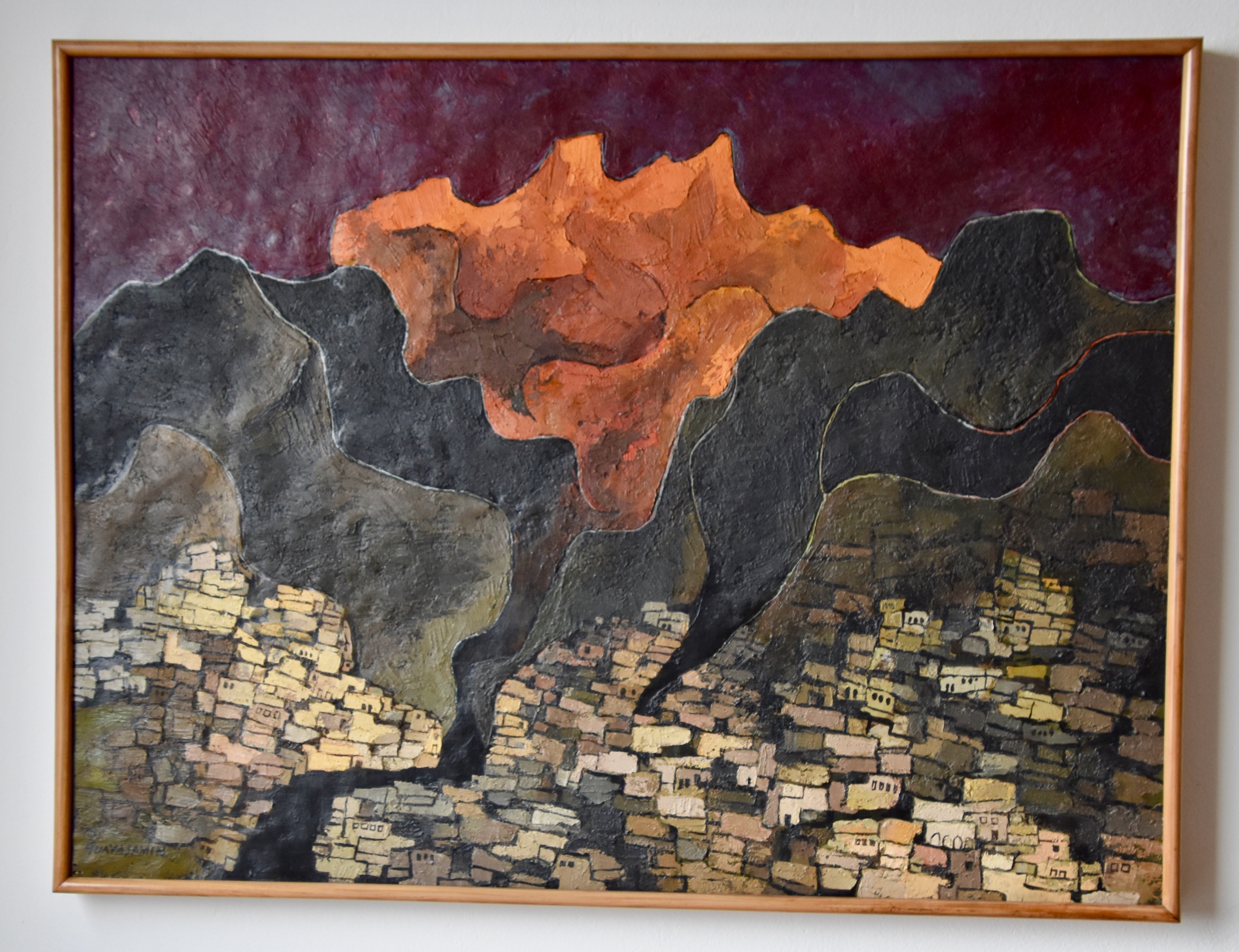
Despite his common roots and dedication to the ‘people’s cause’ Guayasamín lived a pretty cushy lifestyle. His home on the Andean hillside has a swimming pool and extensive gardens as well as being loaded with valuable objects d’art from around the world. It is definitely worth taking the guided tour of the place which lasts much longer than the one in the Capilla del Hombre. Once again I could have done an entire post on the things found inside the home and studio, but again this is a Quito highlights tour so I’ll limit it to three.
This is his studio and library with some unfinished canvases, paints, brushes and other artist’s materials much as it was when he died in 1999. Here you will also find a trove of photographs of Guayasamín with figures like Fidel Castro and Mao Zedong. How he failed to see that these two and pretty well every other Communist leader you can name were every bit as evil and predatory as any of the Latin American right wing dictators he abhorred, is a mystery to me.
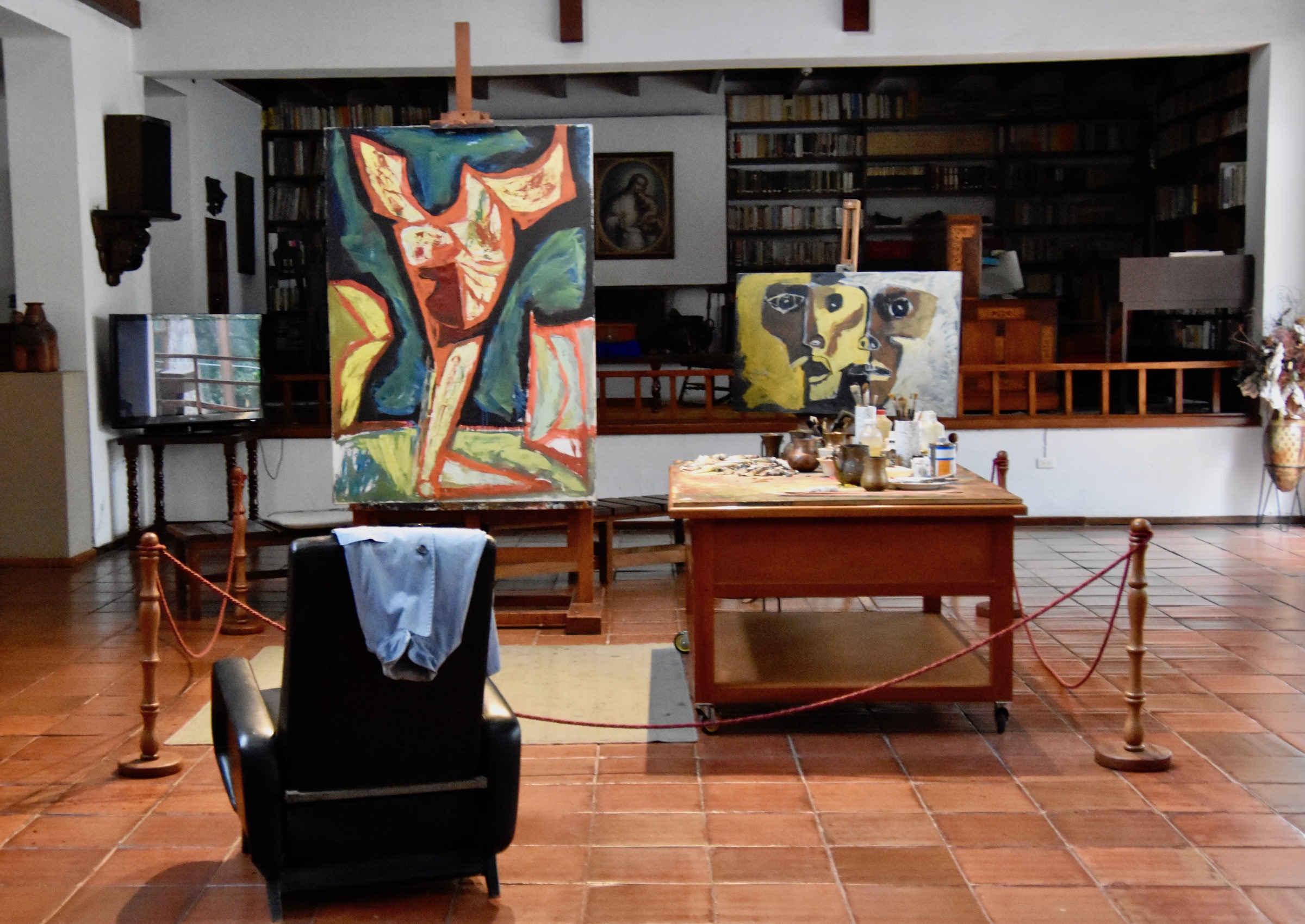
This is the rather impressive bedroom.
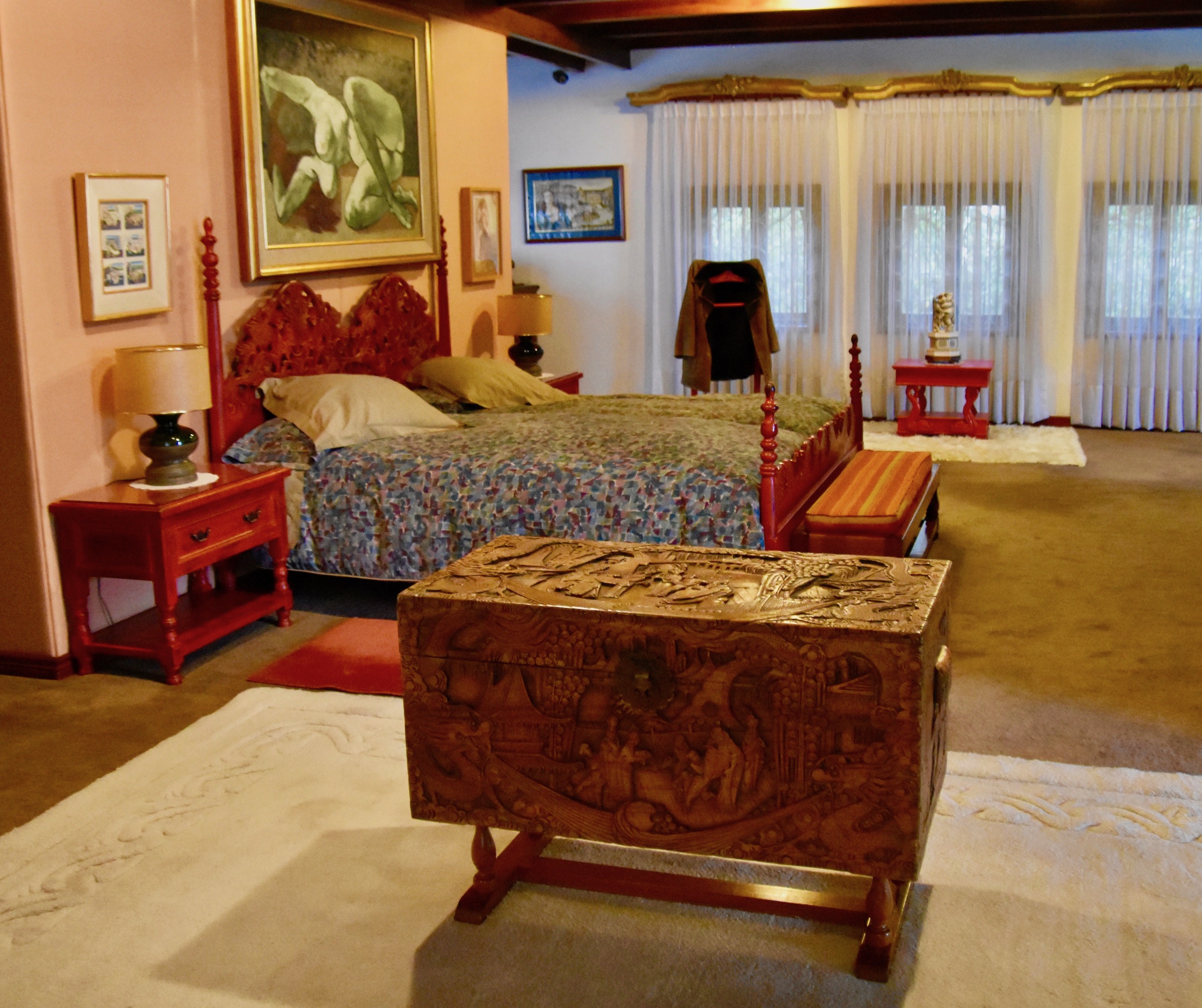
Also in the bedroom is this pre-Viagra collection of sex objects in the literal sense of the word, a sort of pre-Columbian Kama Sutra. Interesting to say the least.
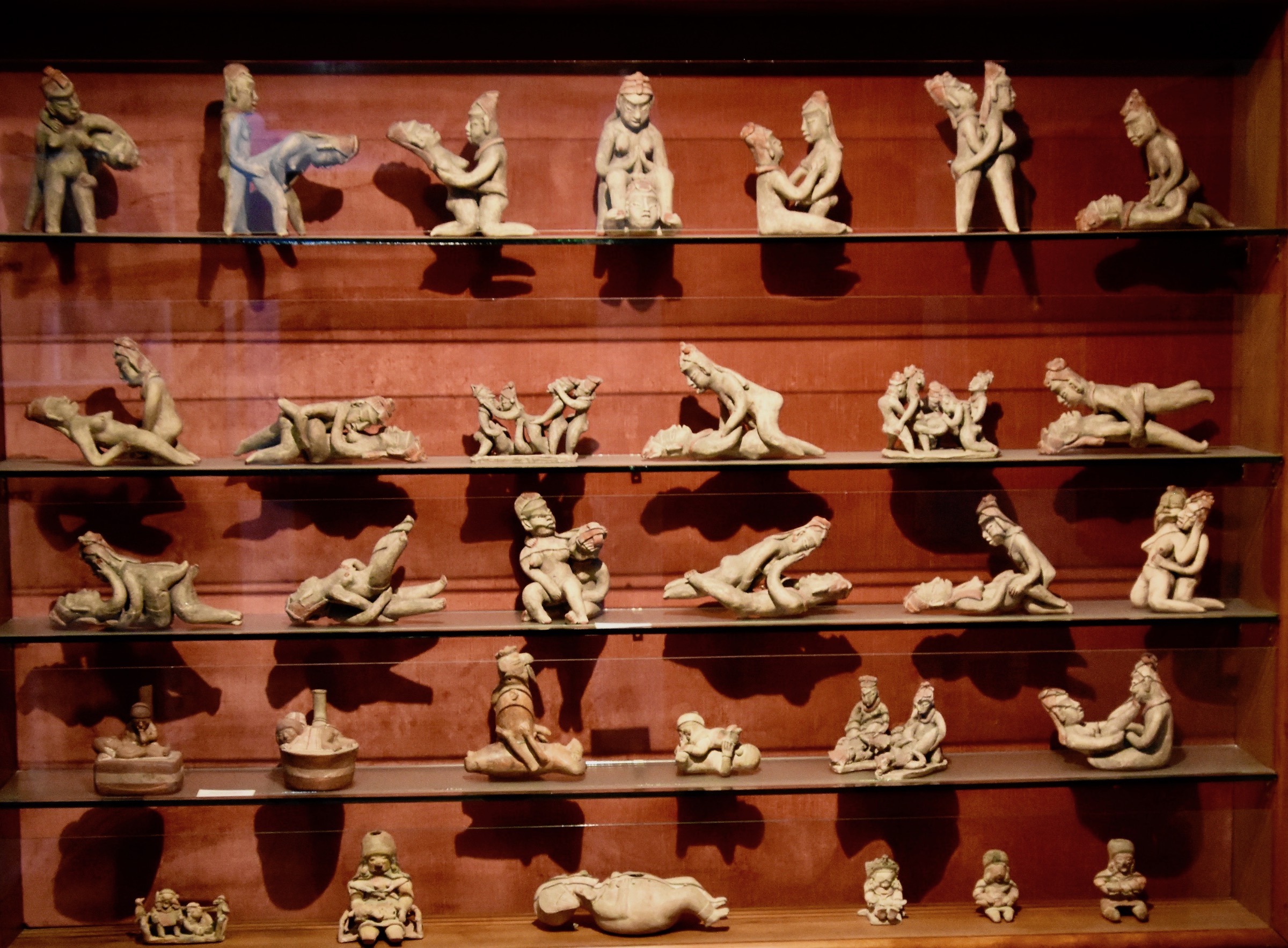
The TeleferiQo
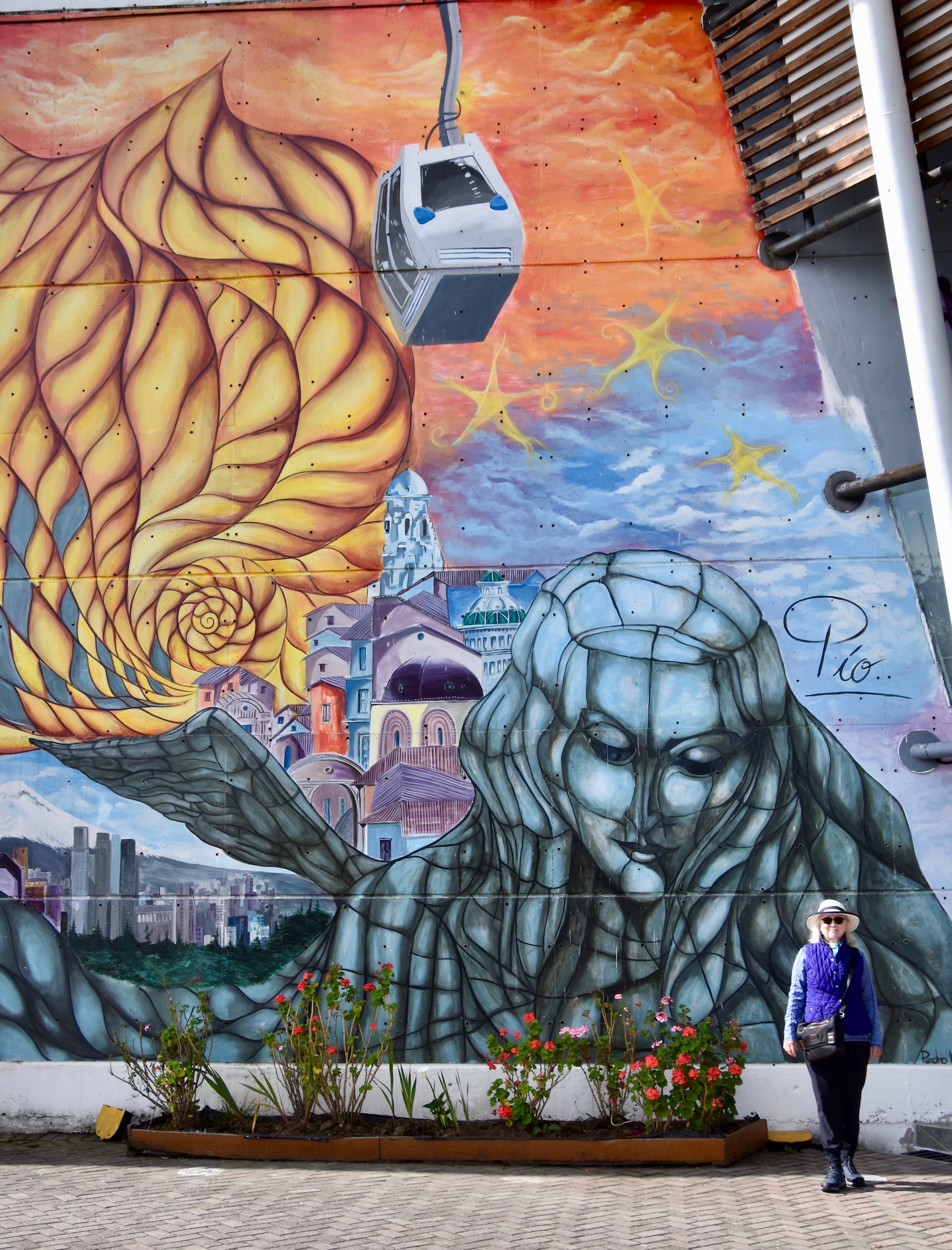
I’ve saved the best of the Quito highlights for the last. The TeleferiQo is a cable car that takes you up to 3,947 metres (12,950 feet) on the slopes of Mount Pichincha volcano. It provides not only stunning views of Quito and the surrounding Andes, but offers the opportunity to hike even higher, right up to the top of Pichincha if you are crazy enough to attempt it. For me this was the one thing outside historic Quito that I had to experience. It will also test your tolerance for very high altitudes so I wouldn’t attempt it on your first day in Quito.
Quito is notorious for being sunny in the morning and cloudy in the afternoon so you’ll want to do this in the morning. However, don’t make the mistake we made of relying upon the opening hours on the website. We did and found out that instead of opening at nine as advertised, it was not opening until 10:00. I would call ahead to confirm the opening hour on the day you want to go.
The taxi ride from central Quito to the TeleferiQo takes you up to 3,117 metres (10,226 feet), the last part of which is a winding drive through a eucalyptus forest. It’s quite pleasant here with lots of birds including a number of really beautiful long-tailed hummingbirds. The one benefit of having arrived way too early was that we did get to go in the first car up, following behind this car with a woman riding on top to visually check the cable I presume.
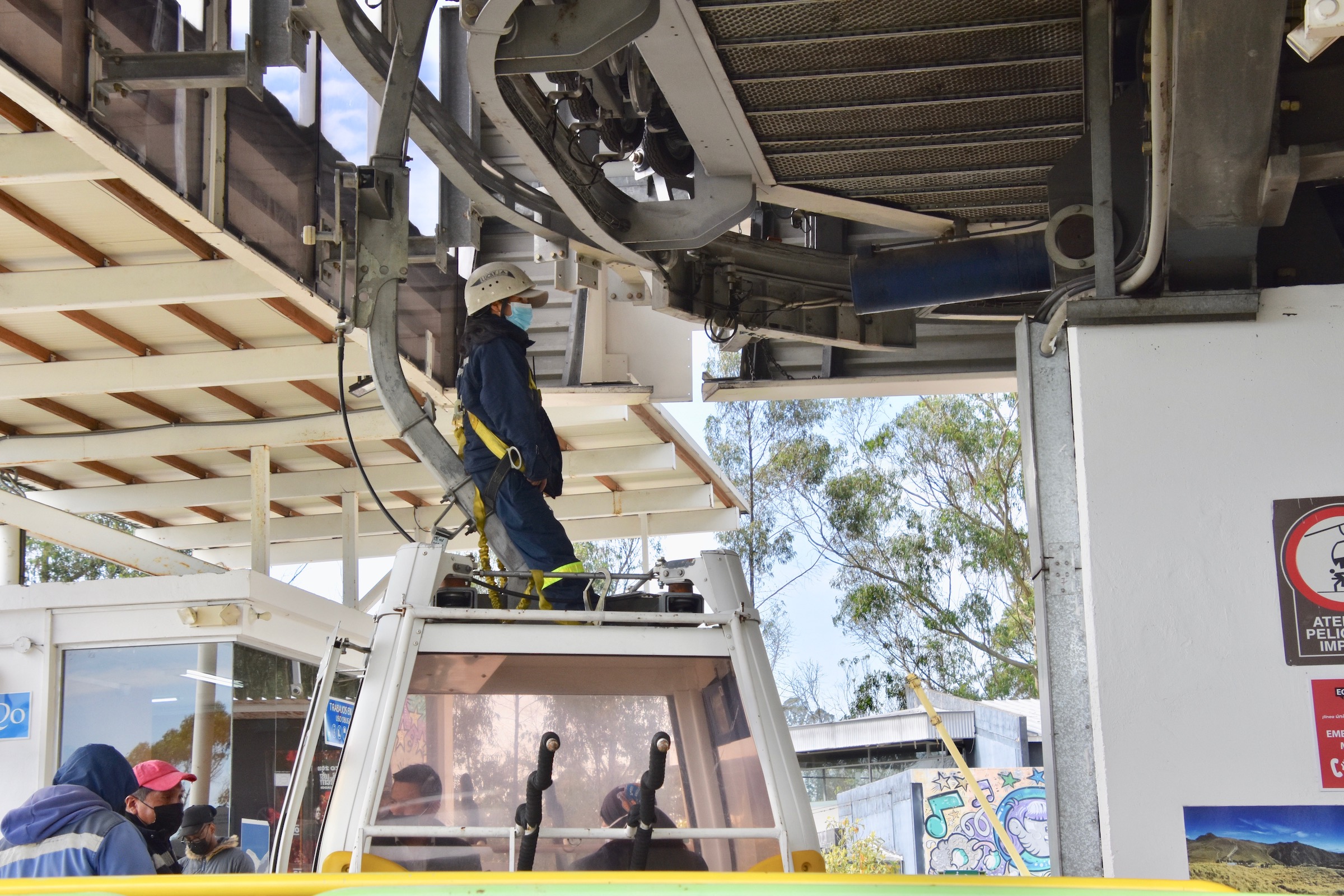
Needless to say the ride up and down provides great views, but they are much better once you actually get out at the top, There are a number of spots from where you can get photos of Quito below and depending upon how clear it is, up to eight volcanoes including the classic conical shape of Cotopaxi.
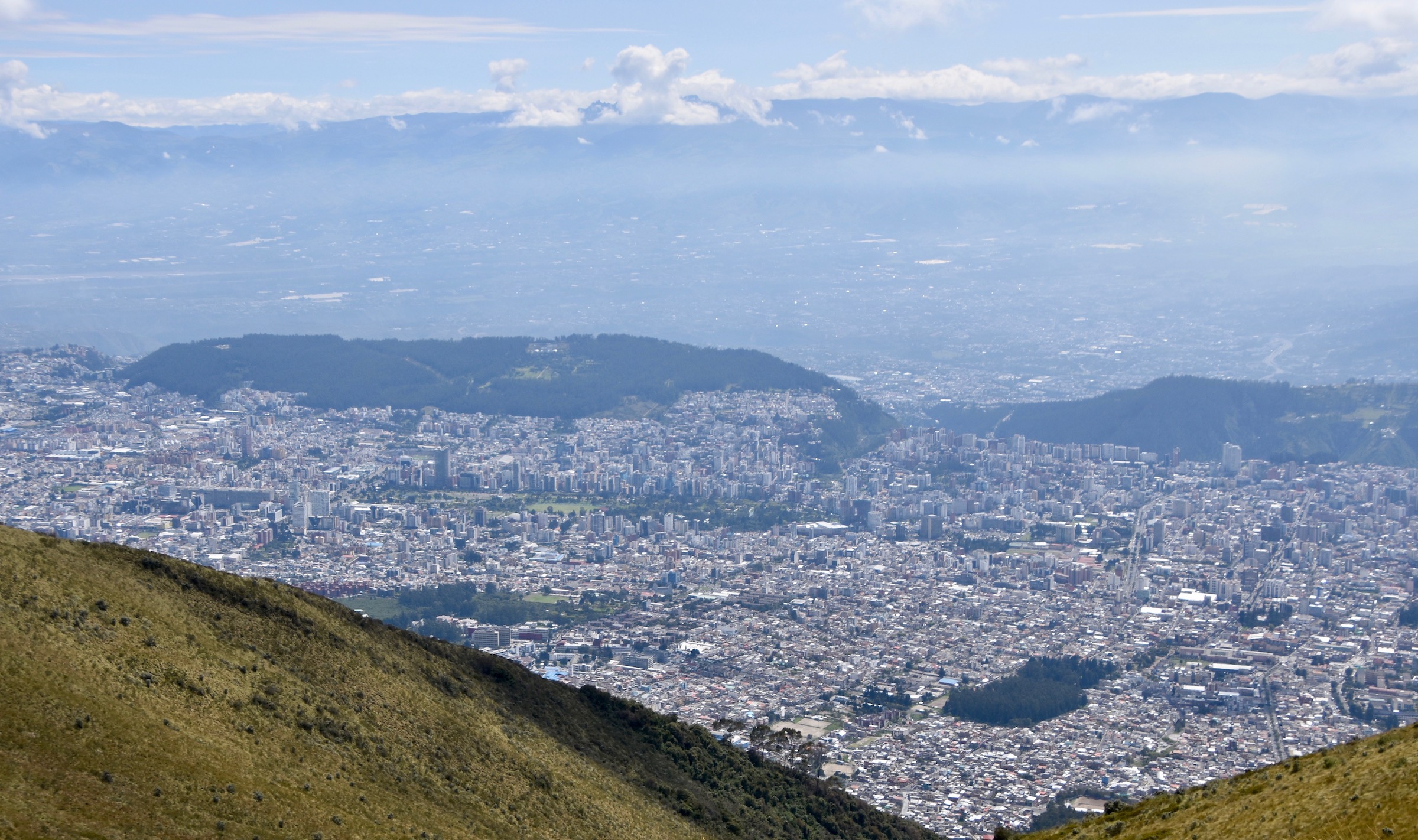
This was the closest I got to getting Cotopaxi to come out of hiding.
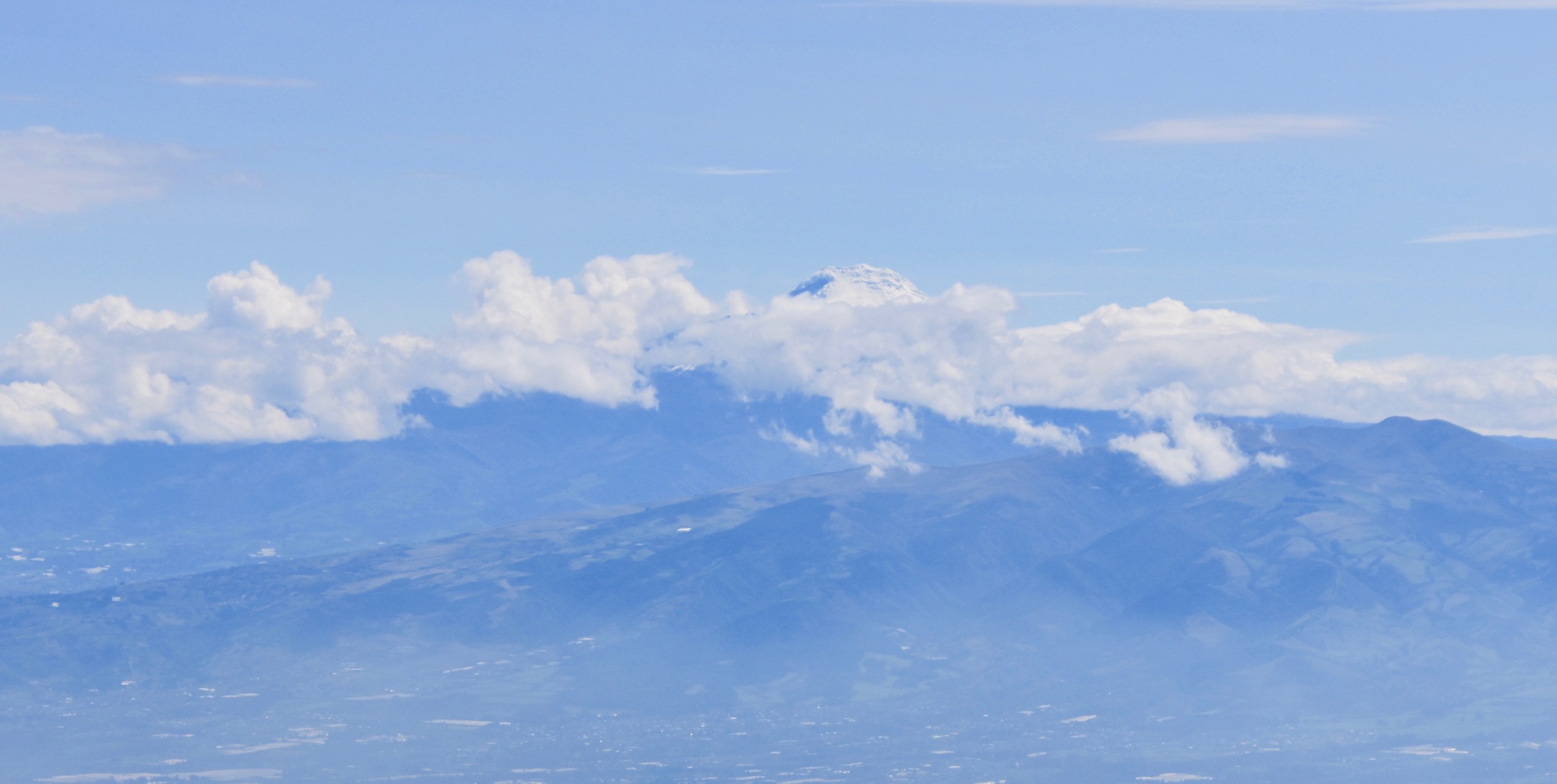
A real Quito highlight is walking out onto the Bridge in the Clouds and getting your photo taken seemingly at the edge of a sheer drop off.
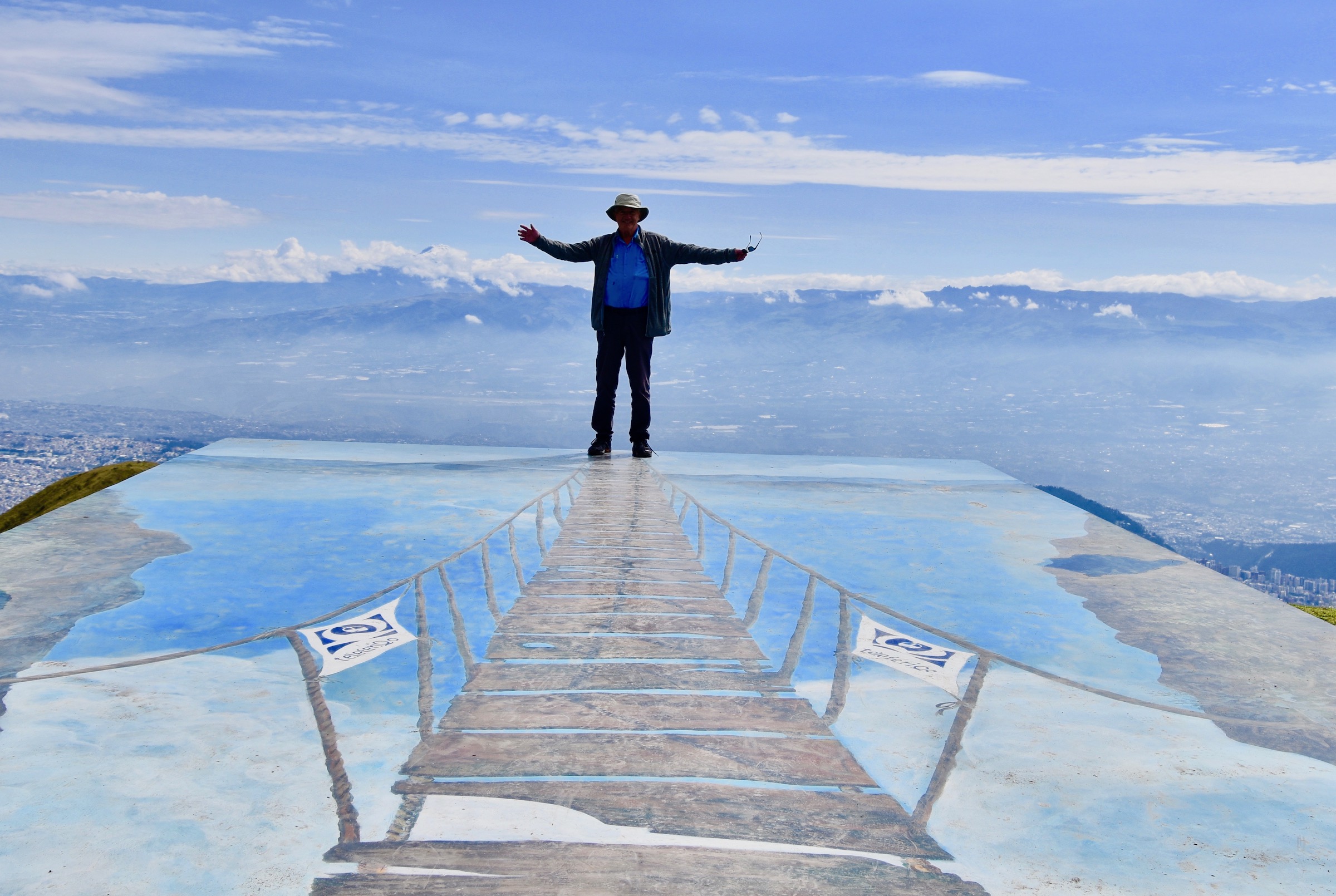
Or inside a mock up of the Teleferiqo.
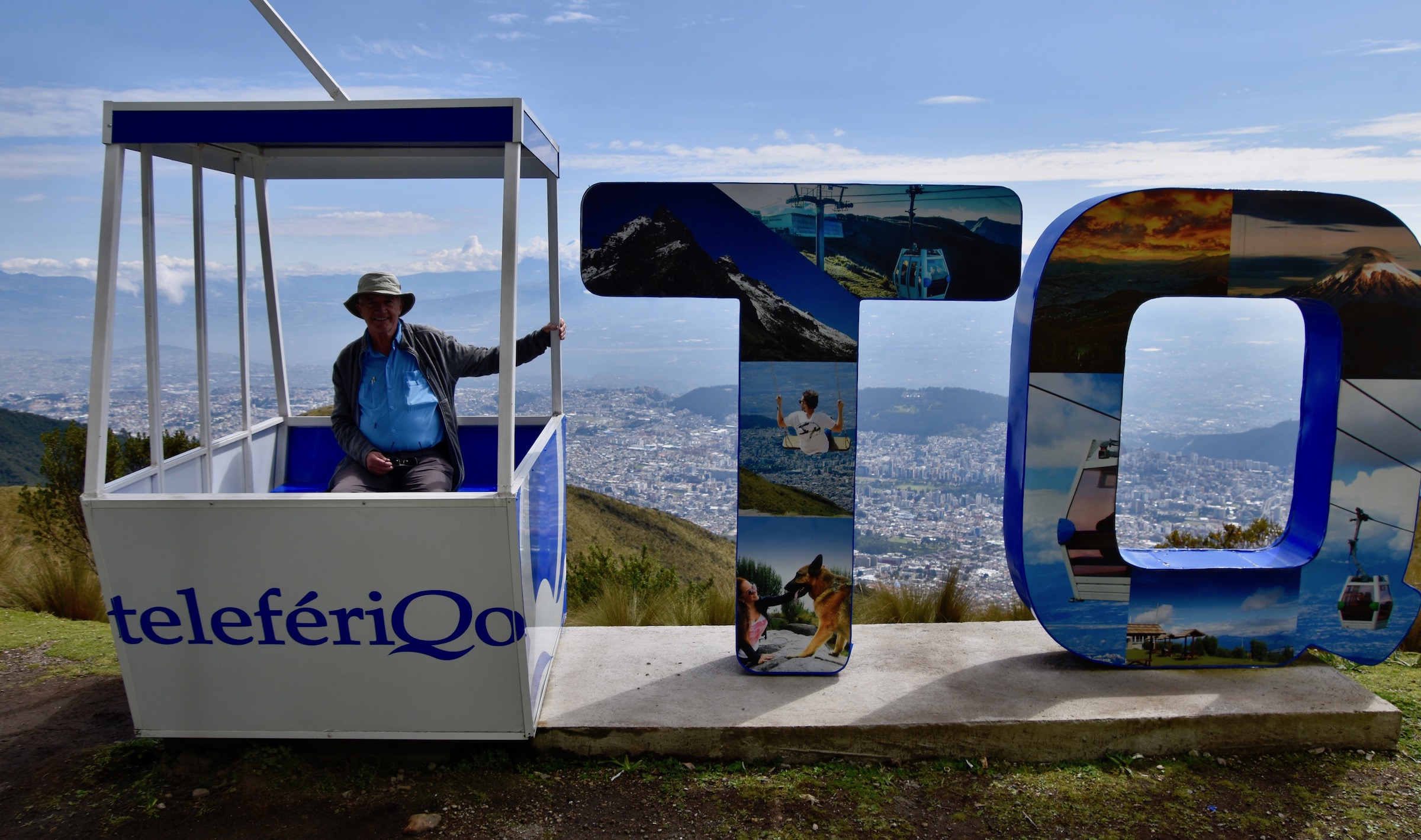
There is also a restaurant and a souvenir store.
If you want to break the 13,000 foot barrier all you need to do is walk our behind the exit station and follow the path that leads upward, all the way to the summit. However you need a guide to do that and you don’t just to go up over 13,000 feet which is a couple of hundred feet from the TeleferiQo station.
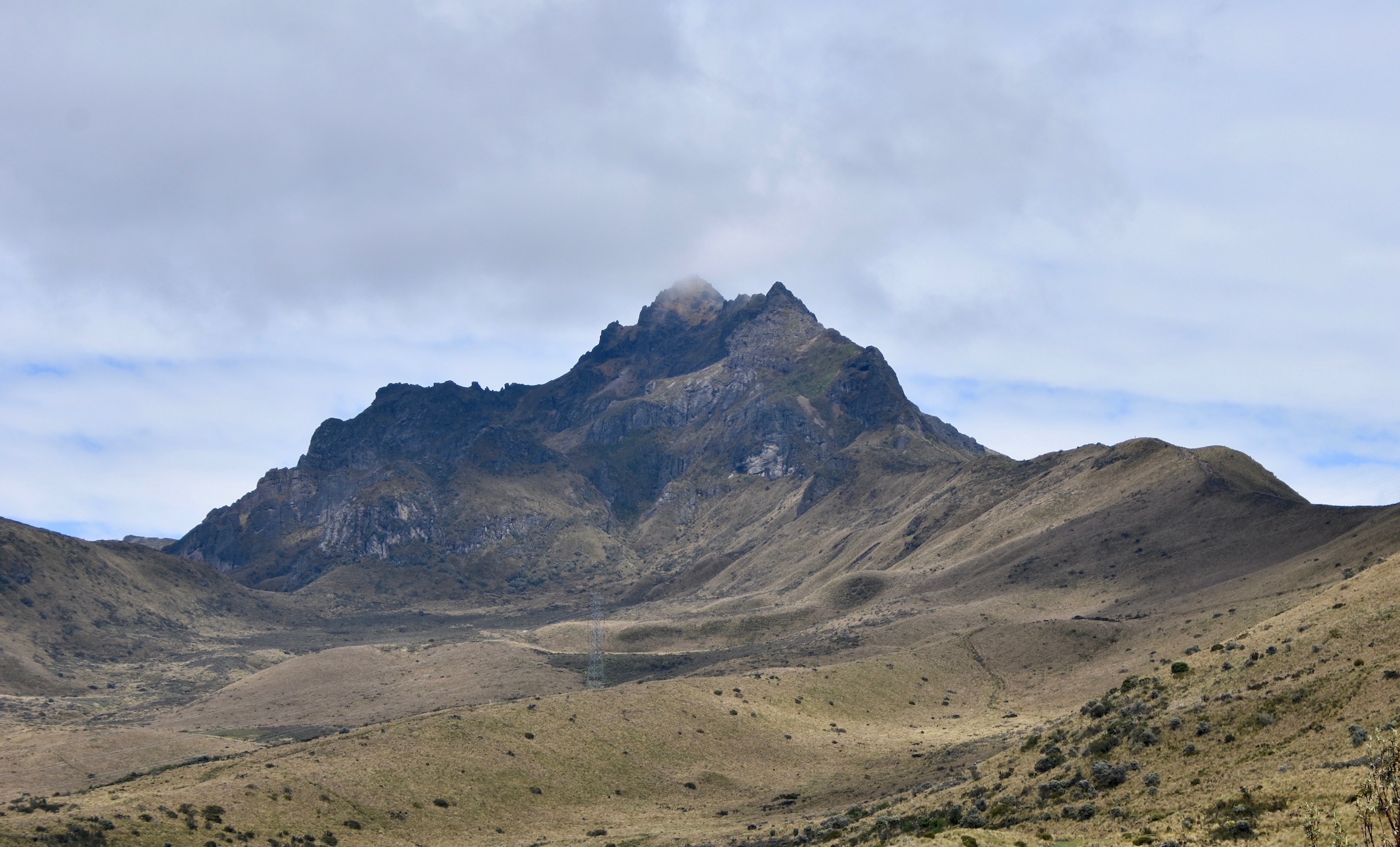
Now I have to admit that this very might be just a little too high for many sea level dwellers, but aside from a brief light headedness it was fine. Alison felt a bit woozy, but we were both happy to set new personal altitude records this day.
Lastly in this post I want to write about something that’s definitely not one of Quito highlights, the bird shit scam. This is a very common occurrence in the touristy areas of Quito, particularly in the La Ronda area which has very narrow streets compared to the rest of the historic centre. Essentially you will be approached from behind by someone, often a couple and often middle-aged, who will have kleenex in hand to help wipe off bird shit which they have just seen land on you. Being bird bombed is quite plausible as the city is overrun with pigeons. However what has really happened is that they have squirted you with a substance and in offering to help are really there to pickpocket you. Or distract you enough so that a third person can come out of nowhere and attempt to grab a purse or camera. This happened to us and the attempt to grab my camera failed as I was holding it in a death grip once I cottoned on to what was happening. Alison was the one who got sprayed, but luckily they didn’t get inside her purse before we realized what was going on. Also numerous bystanders were yelling ‘Bad people, bad people’ at the couple engaged in the scam.
Others we met once the AA trip started weren’t so lucky, one having her wallet stolen. However, these all occurred before the trip started and once we were with our guide Alfredo it was not an issue. So there is a chance you will be victimized if you are on your own. If you are, don’t let anyone come near you and if necessary yell for the police who are never far away in the tourist areas. The good news is that whatever they are using to imitate bird shit it washes off easily and does not leave stains.
Sorry to end this post of Quito highlights on this negative note, but that will be the end of any real perils on this entire trip. Tomorrow we leave Quito and head to one of the last remaining working haciendas in Ecuador. I hope you’ll join us there.

